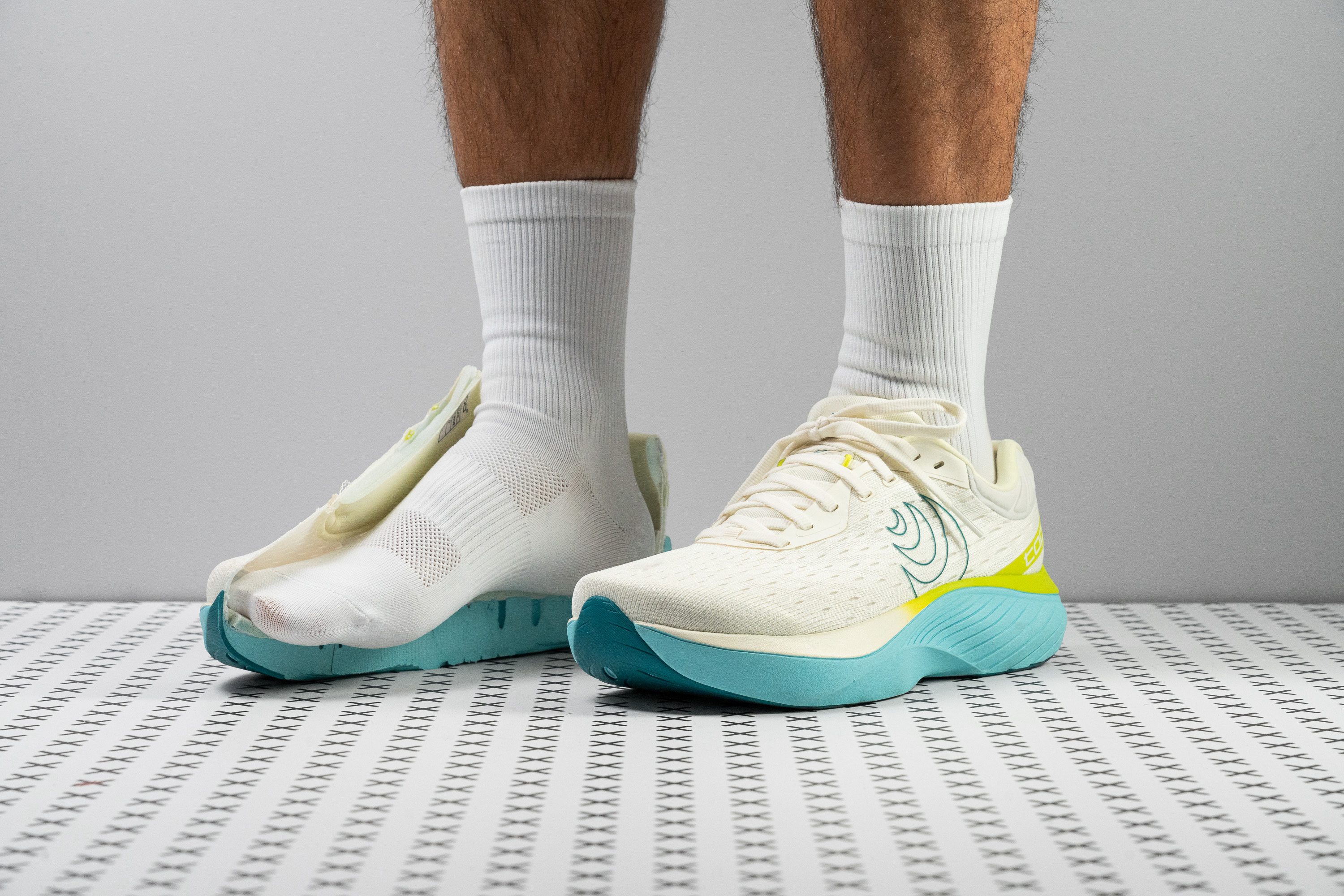Our verdict
- Top pick in best running shoes with a wide toebox
- Top pick in best running shoes for bunions
Pros
- Max-cushioned comfort
- Ultra-spacious toebox
- Stable ride
- Premium Ortholite footbed
- Midfoot-friendly geometry
- Lightweight for its huge size
- Great for easy long runs
- No heel slippage
Cons
- Lacks energy return
- Not for narrow-footed runners
- Could be a bit more flexible
- Not the best for walking
Audience verdict
- Top 14% in road running shoes
- Top 17% in Topo Athletic running shoes
Comparison
The most similar running shoes compared
+ + Add a shoe | |||||
|---|---|---|---|---|---|
| Audience score | 90 Superb! | 89 Great! | 90 Superb! | 86 Good! | |
| Price | £160 | £220 | £200 | £180 | |
| Pace | Daily running | Daily runningTempo | Daily running | Daily running | |
| Arch support | Neutral | Neutral | Neutral | Neutral | |
| Weight lab Weight brand | 9.7 oz / 275g 9.7 oz / 275g | 9.1 oz / 258g 9 oz / 255g | 8.7 oz / 247g 9.2 oz / 261g | 10.5 oz / 299g 10.8 oz / 305g | |
| Lightweight | ✗ | ✗ | ✓ | ✗ | |
| Drop lab Drop brand | 5.3 mm 5.0 mm | 6.7 mm 6.0 mm | 5.9 mm 6.0 mm | 8.3 mm 8.0 mm | |
| Strike pattern | Mid/forefoot | Mid/forefoot | Mid/forefoot | HeelMid/forefoot | |
| Size | True to size | True to size | True to size | True to size | |
| Midsole softness | Balanced | Soft | Soft | Balanced | |
| Difference in midsole softness in cold | Normal | Small | Small | Small | |
| Toebox durability | Decent | Decent | Bad | Decent | |
| Heel padding durability | Good | Bad | Good | Good | |
| Outsole durability | Good | Good | Good | Good | |
| Breathability | Moderate | Moderate | Moderate | Moderate | |
| Width / fit | Wide | Medium | Medium | Medium | |
| Toebox width | Wide | Medium | Medium | Medium | |
| Stiffness | Moderate | Moderate | Moderate | Stiff | |
| Torsional rigidity | Stiff | Stiff | Stiff | Stiff | |
| Heel counter stiffness | Stiff | Moderate | Stiff | Stiff | |
| Rocker | ✗ | ✗ | ✓ | ✓ | |
| Heel lab Heel brand | 37.8 mm 38.0 mm | 39.7 mm 37.0 mm | 37.8 mm 38.5 mm | 42.7 mm 44.0 mm | |
| Forefoot lab Forefoot brand | 32.5 mm 33.0 mm | 33.0 mm 31.0 mm | 31.9 mm 32.5 mm | 34.4 mm 36.0 mm | |
| Widths available | NormalWide | Normal | NormalWide | NormalWideX-Wide | |
| Orthotic friendly | ✓ | ✓ | ✓ | ✓ | |
| Season | All seasons | All seasons | All seasons | All seasons | |
| Removable insole | ✓ | ✓ | ✓ | ✓ | |
| Ranking | #41 Top 12% | #96 Top 27% | #69 Top 19% | #177 Top 49% | |
| Popularity | #155 Top 43% | #172 Top 47% | #51 Top 14% | #18 Top 5% |
Who should buy
The Topo Atmos stands out as a compelling daily trainer for:
- Runners seeking a max-cushioned shoe with a generously spacious toebox while avoiding a zero-drop platform.
- Longtime Topo Athletic fans excited for a high-stack workhorse to complement their rotation.
- Midfoot or forefoot strikers looking for a long-distance shoe with unmatched toe splay.
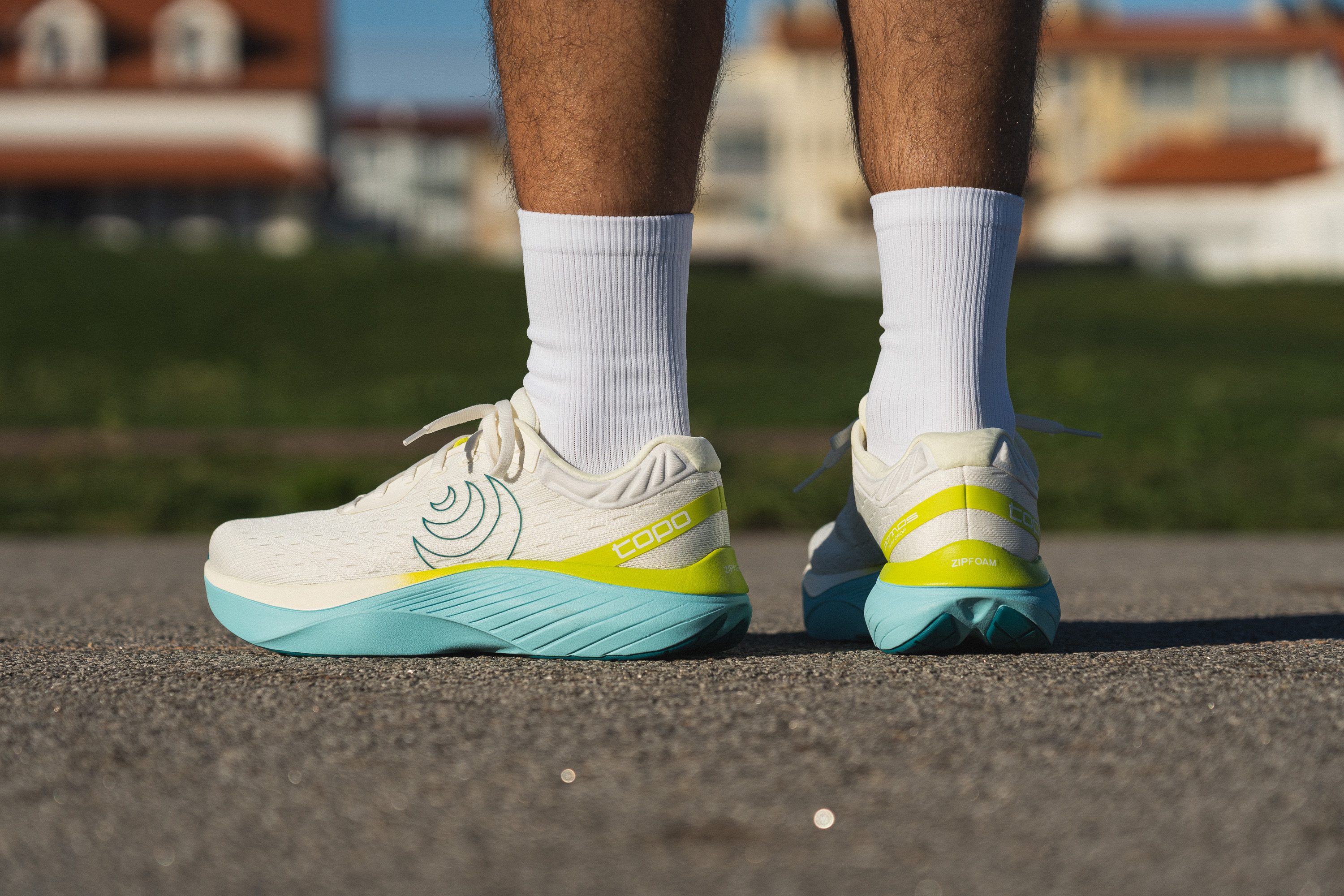
Who should NOT buy
We believe that runners seeking an ultra-plush ride will find the Atmos underwhelming—its ZipFoam midsole lacks the soft, sink-in feel of some max-cushioned trainers. If comfort-driven cushioning is your priority, we suggest the New Balance Fresh Foam 1080 v14, especially for those with narrow feet who need a more tailored fit.
From our perspective, Topo fans accustomed to the brand’s nimble designs may also be disappointed. The Atmos is a bulky, rigid workhorse that sacrifices agility for stability. If that’s a concern, we recommend the Topo Cyclone 2, which delivers a more energetic and lightweight experience.
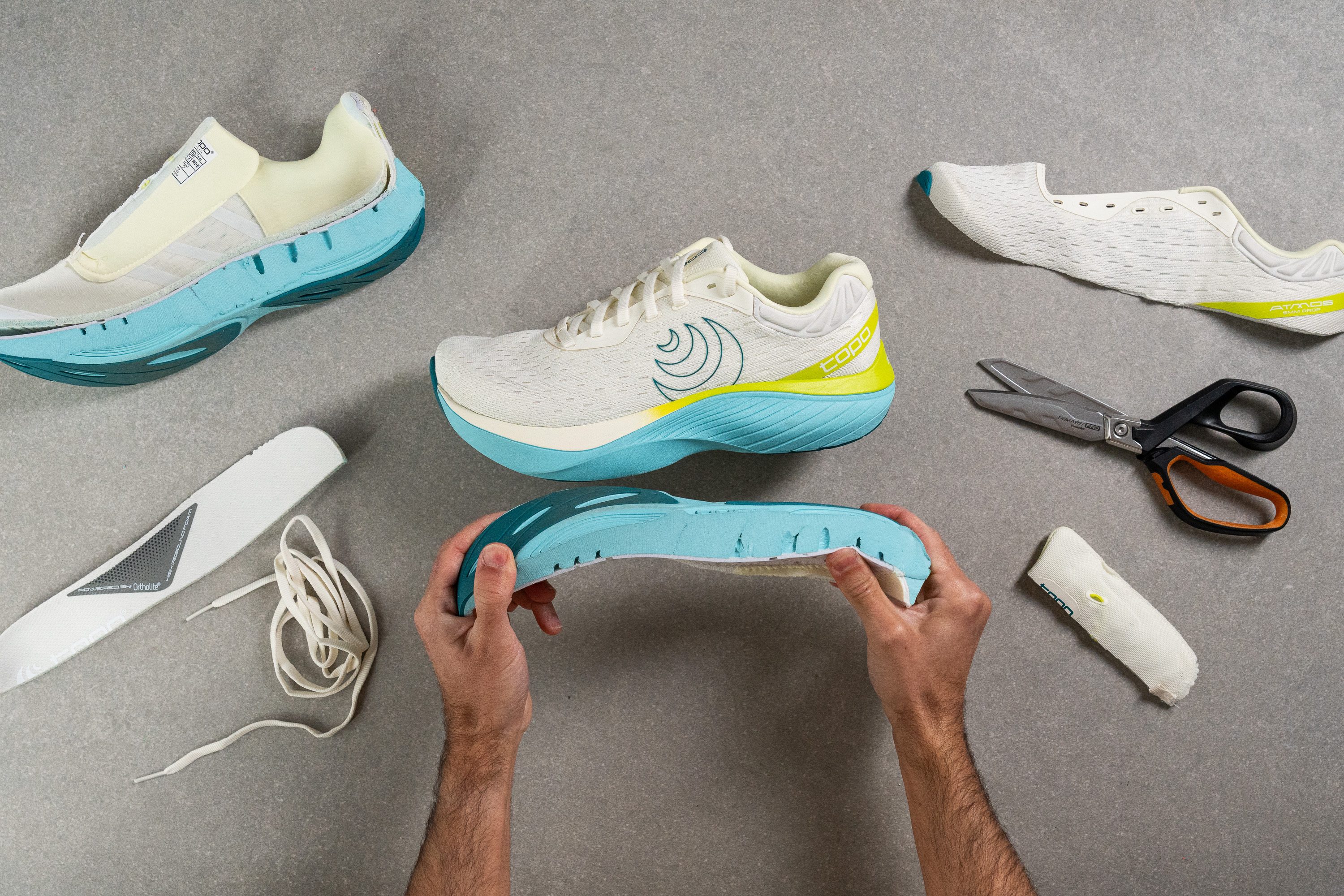
Additionally, die-hard zero-drop runners will likely pass on this one—it has a moderate drop, making the Altra VIA Olympus 2 a better alternative.
Cushioning
Shock absorption
Thanks to its low-drop design, the Atmos delivers better forefoot cushioning than most running shoes on the market. But with 130 SA in the heel and 122 SA in the forefoot, it easily protects all footstrikes from pounding.
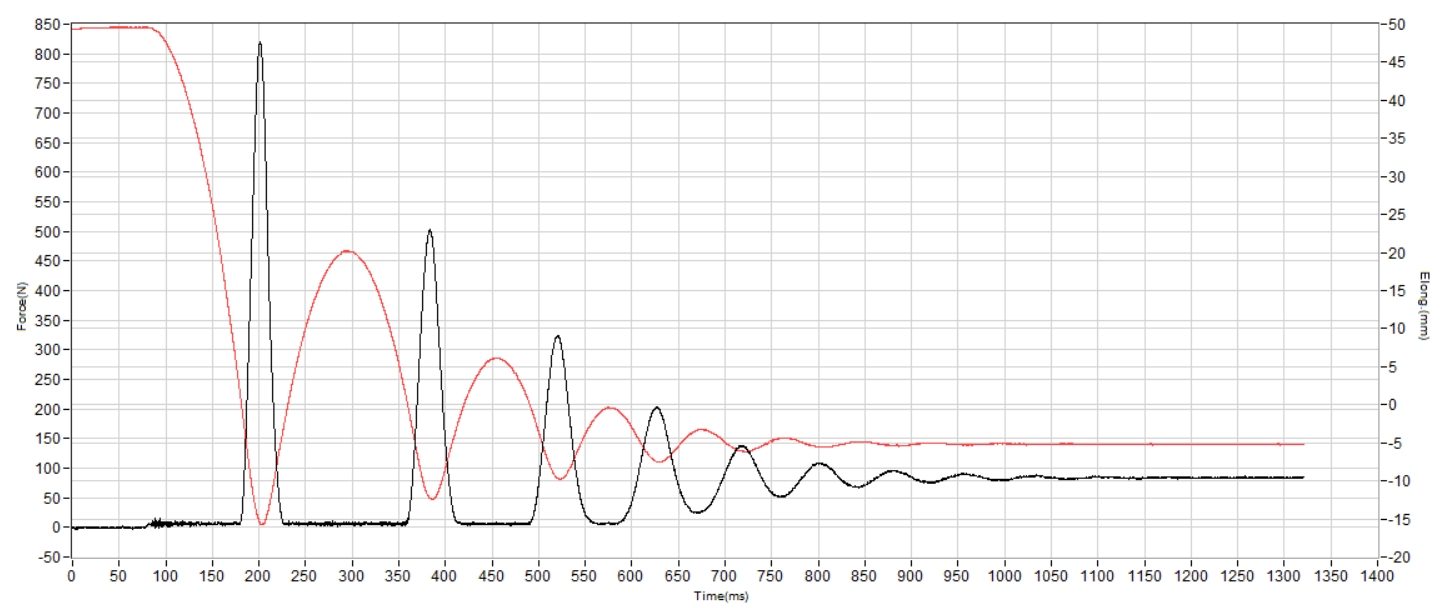
| Topo Atmos | 130 SA |
| Average | 130 SA |
Energy return
The Topo Atmos brings plenty of strengths to the table, but energy return isn’t one of them. It reached just 48.3% in the heel and 50.0% in the forefoot, both far below what we expect from a modern daily trainer.
| Topo Atmos | 48.3% |
| Average | 58.6% |
Heel stack
A frequent critique of Topo has been its limited lineup, with no presence in key categories like supershoes (still absent) and max-cushioned trainers (finally here!).
Therefore, with a substantial 37.8 mm stack in the heel, the Atmos officially enters the maximalist market—offering Topo fans a well-cushioned, long-distance training option. We confirmed with our callipers that heel protection is more than sufficient, making it a solid choice for marathon training.
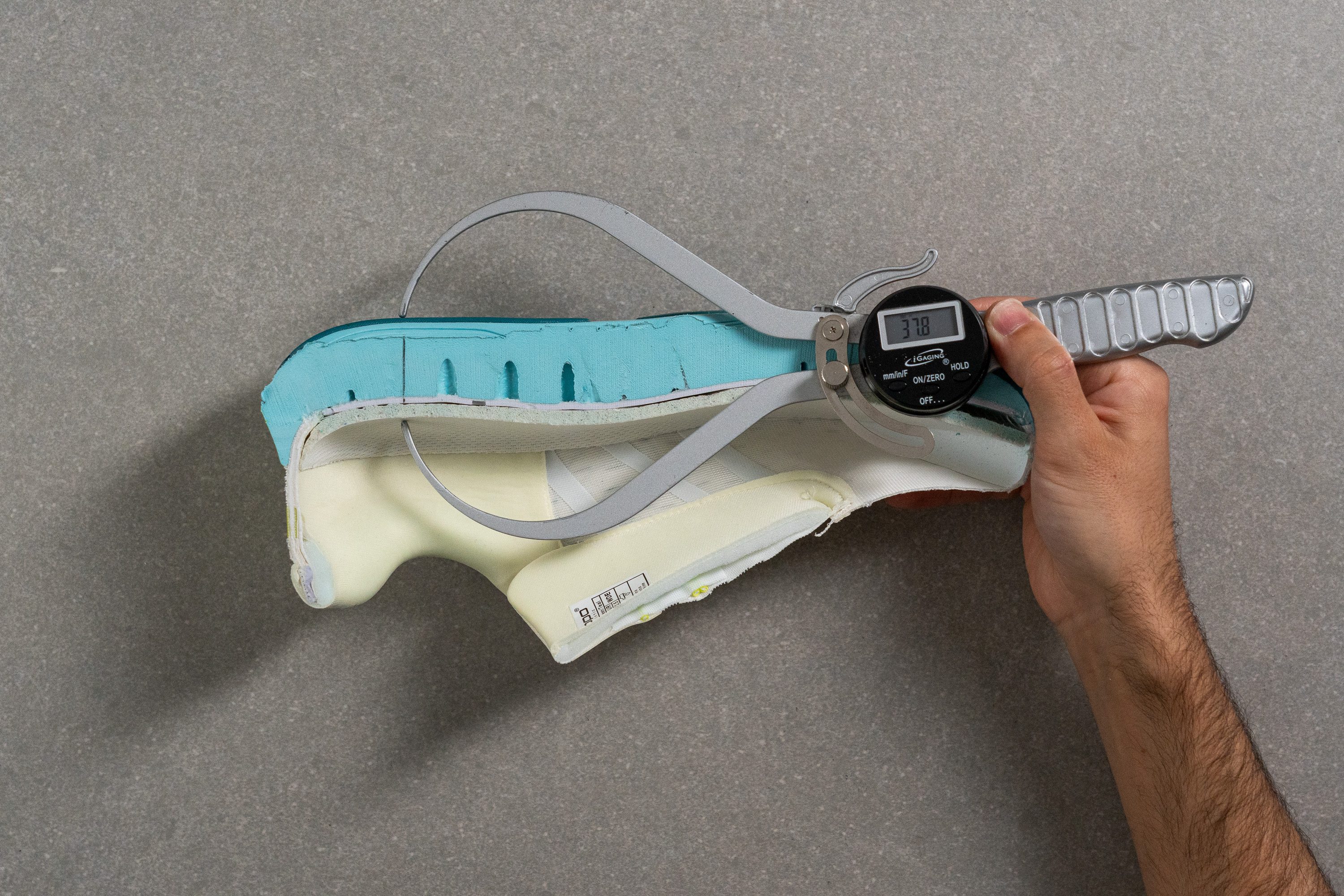
| Topo Atmos | 37.8 mm |
| Average | 34.8 mm |
Forefoot stack
If the heel felt cushioned compared to the average shoe, the forefoot takes it even further—creating a significant gap from most daily trainers. We measured 32.5 mm under the ball of the foot, and for those prioritising impact absorption, the Atmos excels.
Does this feel excessive? It might—after all, it's over 30 mm! But if that seems too much, the Topo Phantom 3 offers a slightly lower stack height and could be a better fit for you.
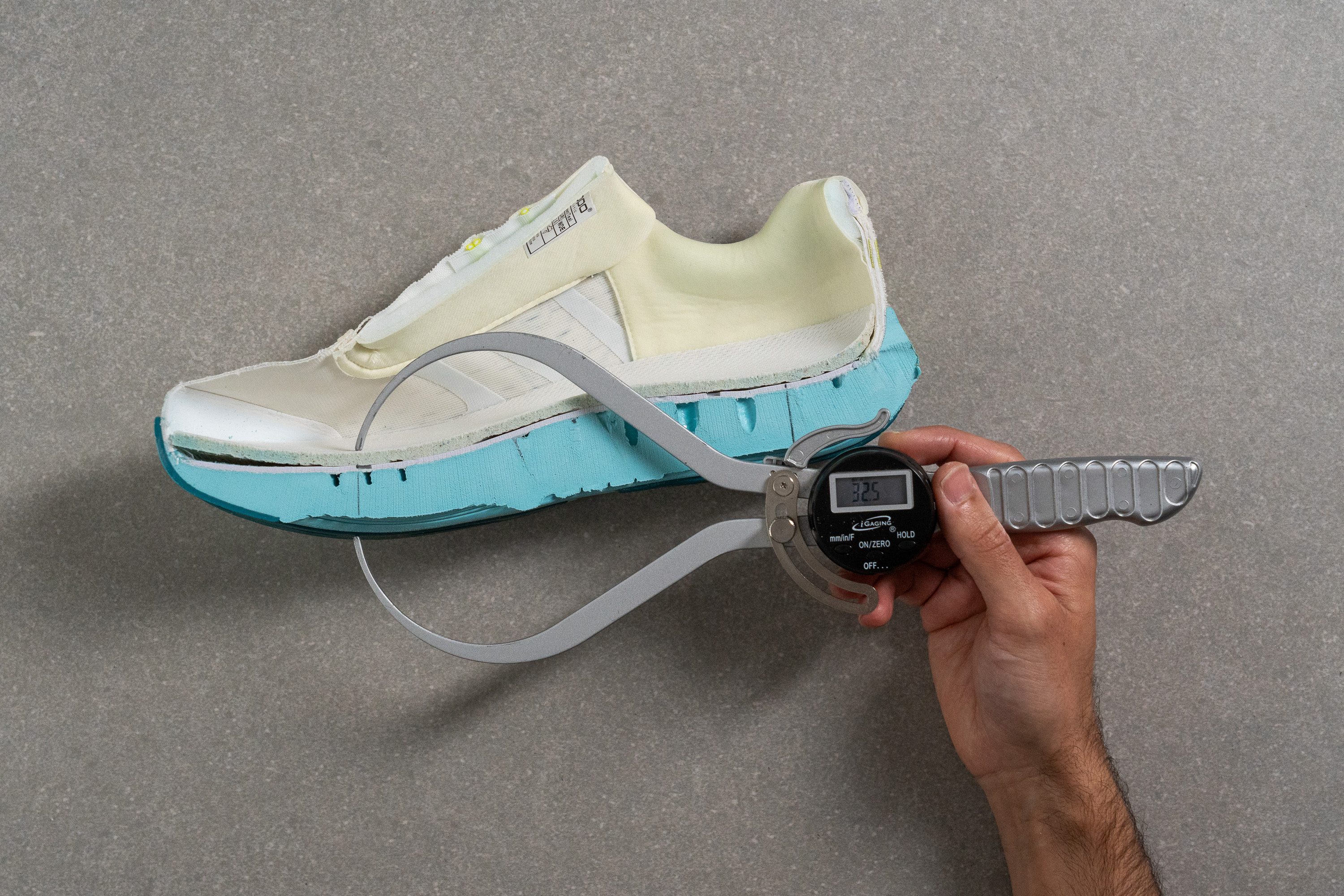
| Topo Atmos | 32.5 mm |
| Average | 26.2 mm |
Drop
Like other Topo shoes we've tested in the lab, the Atmos is designed with a 5-mm drop. Our measurements showed 5.3 mm—an impressive level of accuracy, as most brands rarely come this close to their stated drop.
With this moderate drop, the Atmos suits a wide range of runners, though we found it best tailored for midfoot and forefoot strikers.
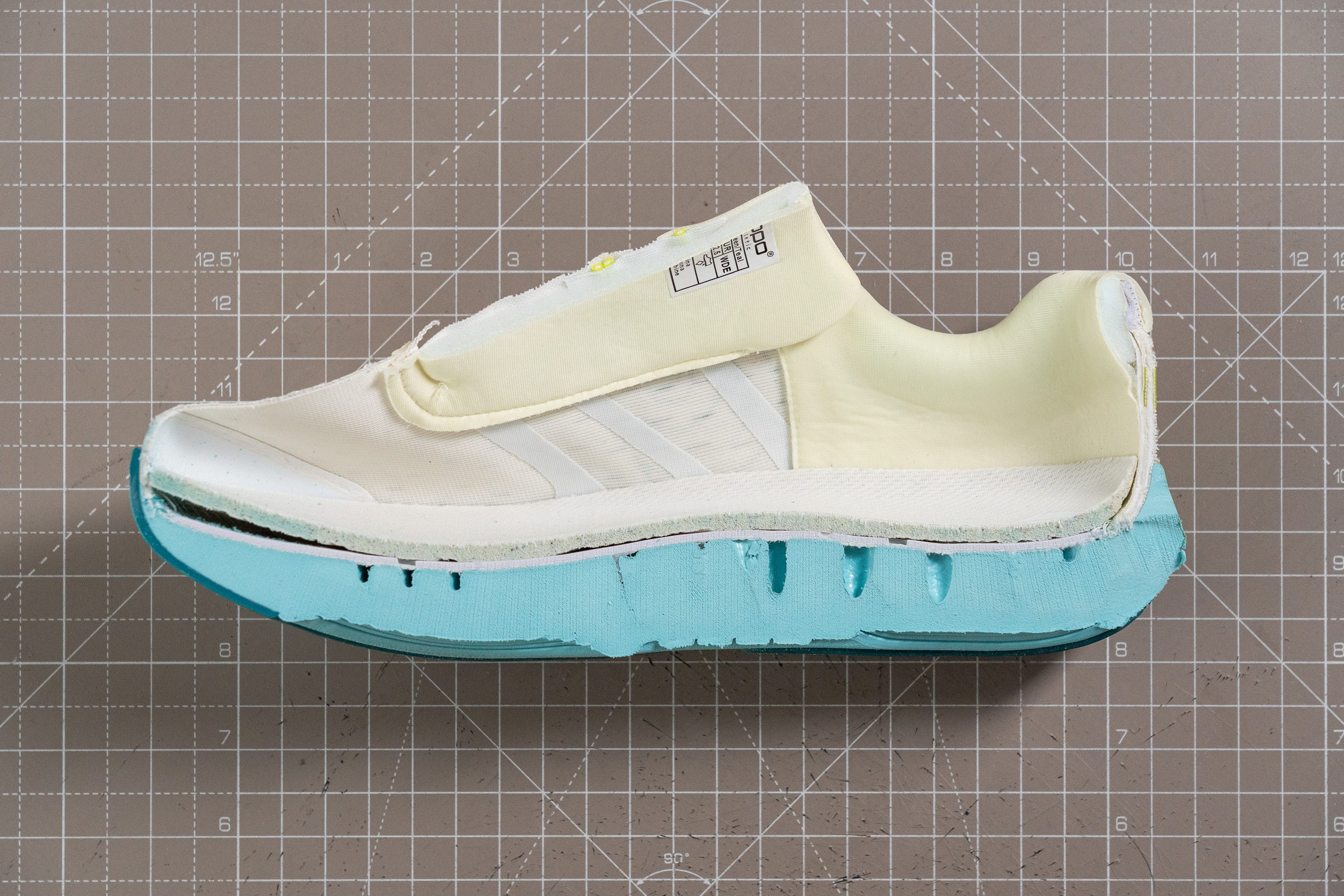
| Topo Atmos | 5.3 mm |
| Average | 8.6 mm |
Midsole softness
ZipFoam has never been a plush midsole—Topo prioritises a balanced feel over an ultra-soft ride, which might not appeal to everyone. However, we think this approach makes sense for a max-cushioned trainer, ensuring stability without excessive compliance.
In the Atmos, we pressed our durometer against ZipFoam and recorded 20.0 HA, which felt just average underfoot. As for energy return, don’t expect a high-bounce sensation—it performs decently but falls far short of the responsiveness found in supercritical or PEBA-based foams like the Saucony Triumph 22.
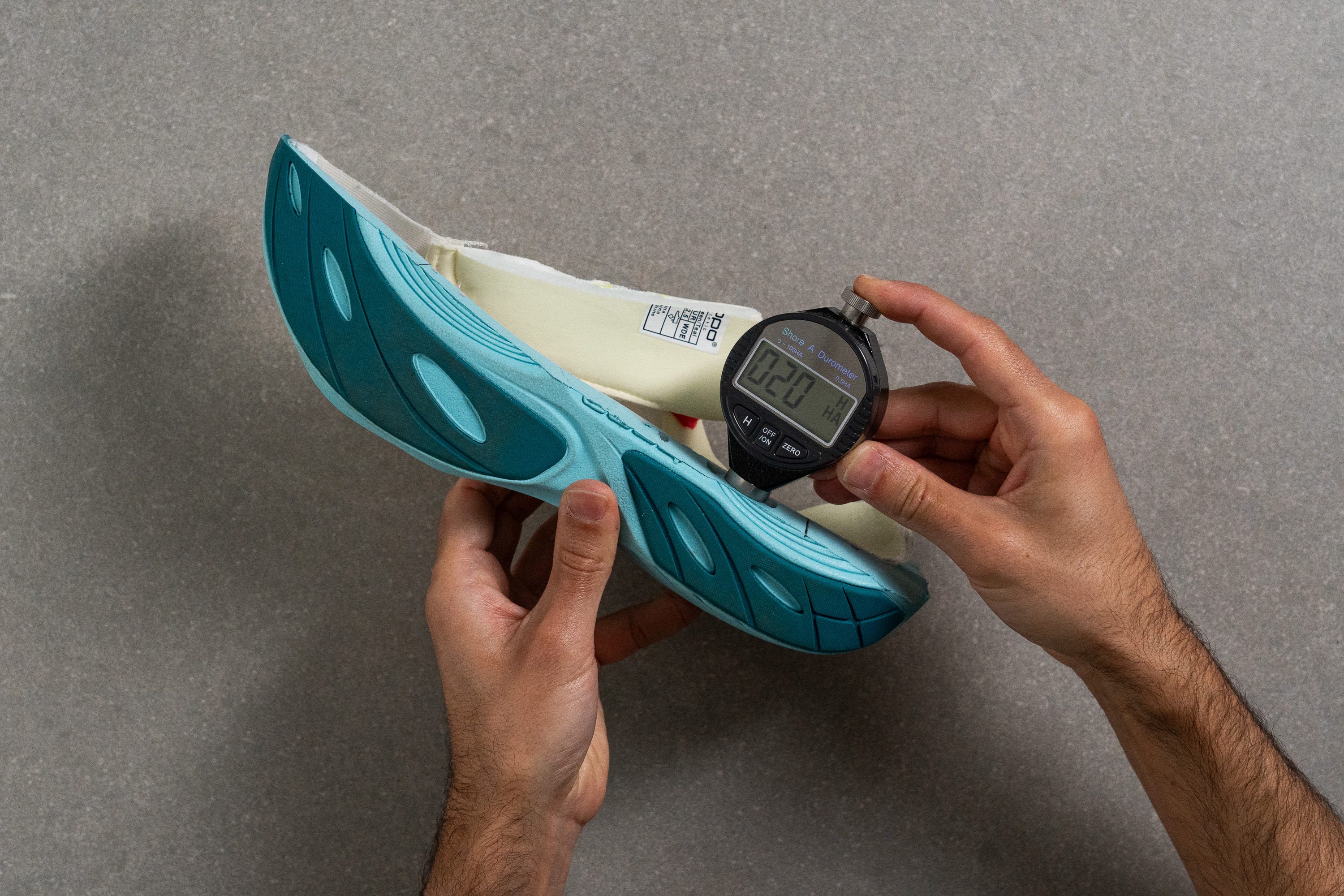
| Topo Atmos | 20.0 HA |
| Average | 20.4 HA |
Rocker
Another signature of Topo's design is its resistance to the ultra-rockered shapes seen in other brands. The Atmos follows this trend, delivering a more traditional ride without an exaggerated curvature.
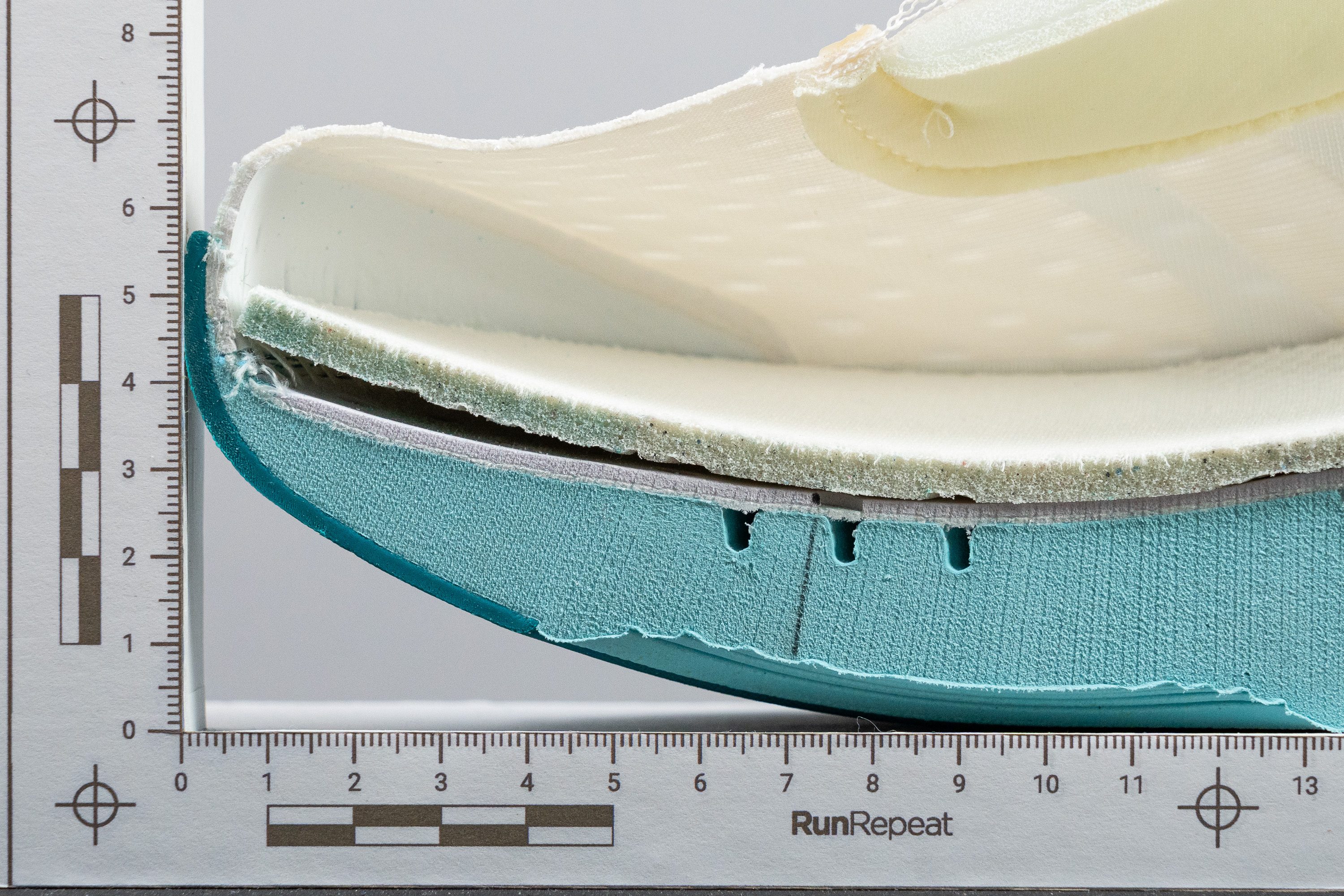
Size and fit
Size
Topo Atmos fits true to size (78 votes).
Width / Fit
One of Topo's biggest draws is its signature foot-shaped toebox, so we set out to create an exact replica of its interiors to see if the Atmos lives up to the hype.
We took three key measurements, starting with the widest part of the shoe. Our callipers recorded 98.5 mm—an excellent start for wide-footed runners.
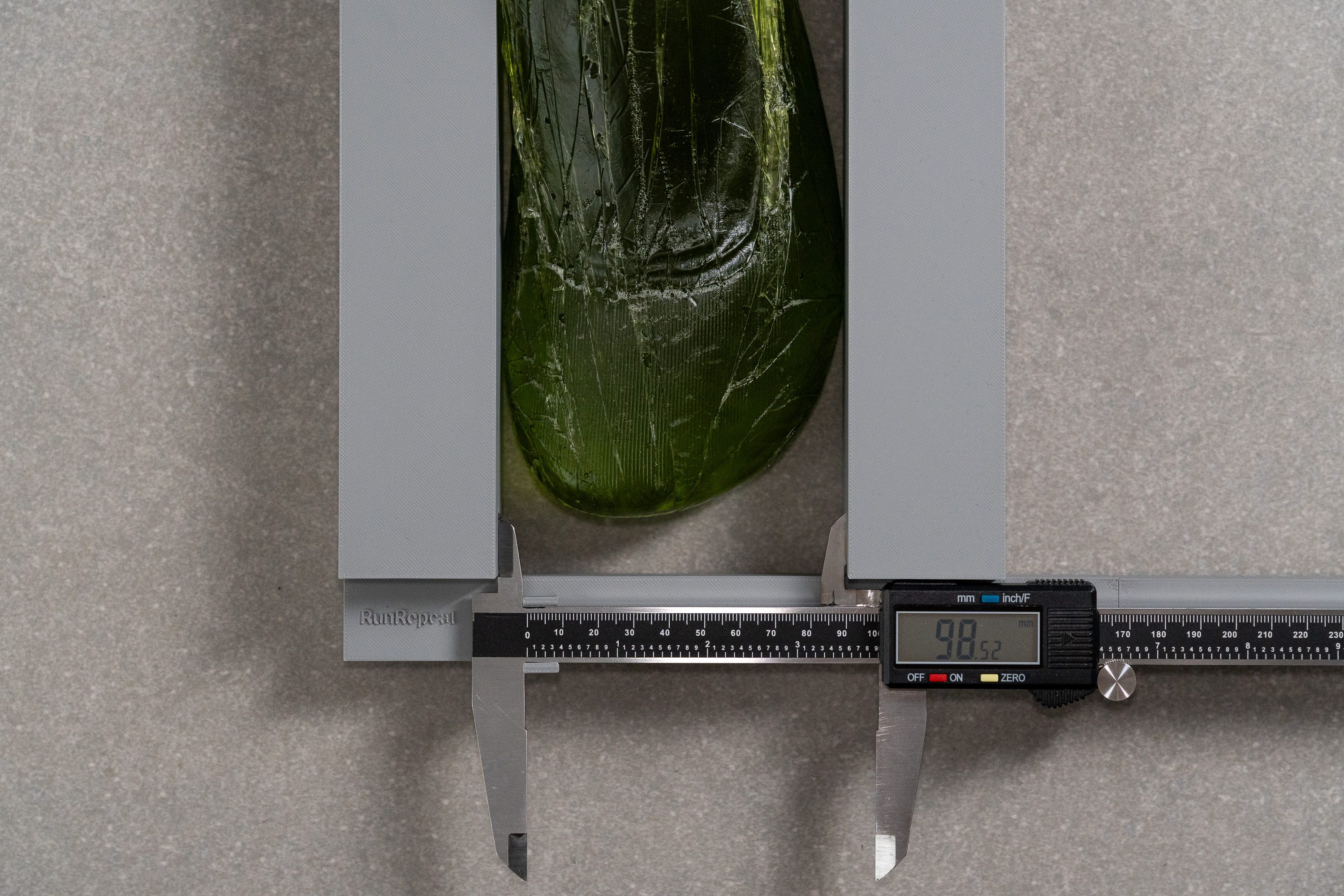
| Topo Atmos | 98.5 mm |
| Average | 95.1 mm |
Toebox width
Here’s where the magic happens. With an impressive 85.0 mm width in the big toe area, we confirmed that the Atmos offers a truly anatomical toebox that respects the natural shape of the foot.
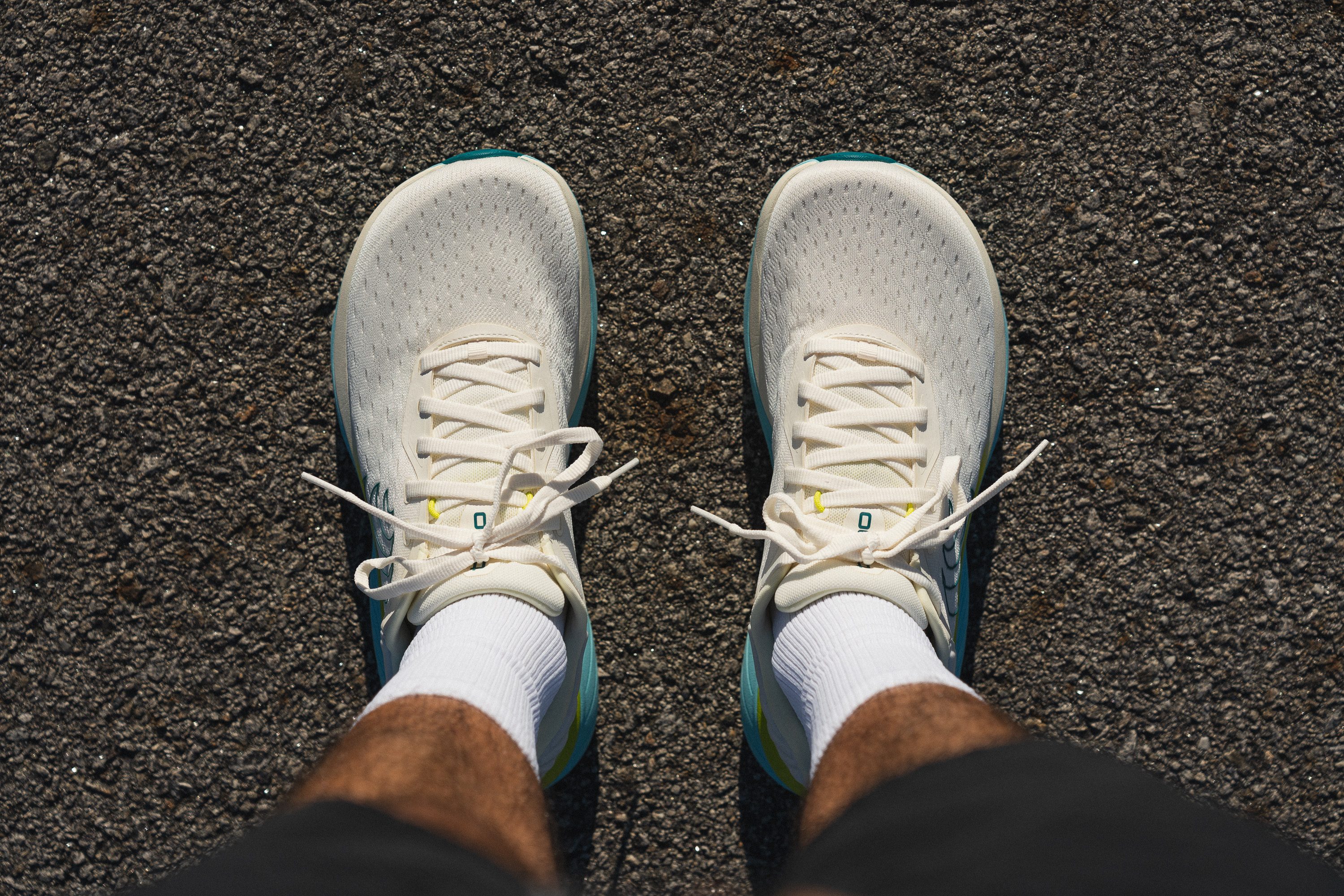
While it may not suit narrow-footed runners, the market is already saturated with tapered competitors, like the ASICS Novablast 5 or the Adidas Supernova Prima.
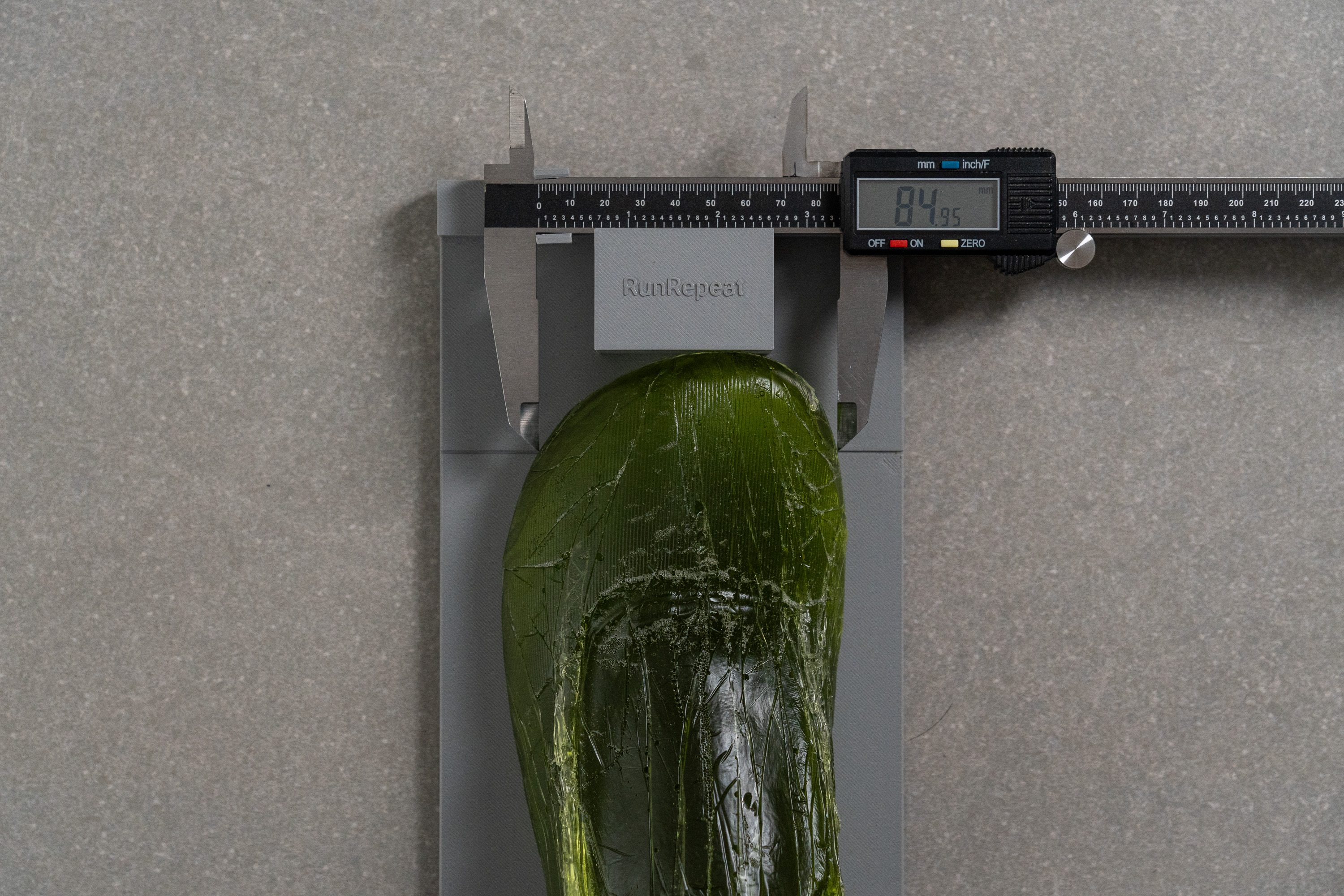
| Topo Atmos | 85.0 mm |
| Average | 73.3 mm |
Toebox height
The toebox of the Atmos isn’t just impressively wide—it’s also remarkably tall at 29.8 mm.
This combination makes it an outstanding choice for runners with high-volume feet seeking extra room and comfort.
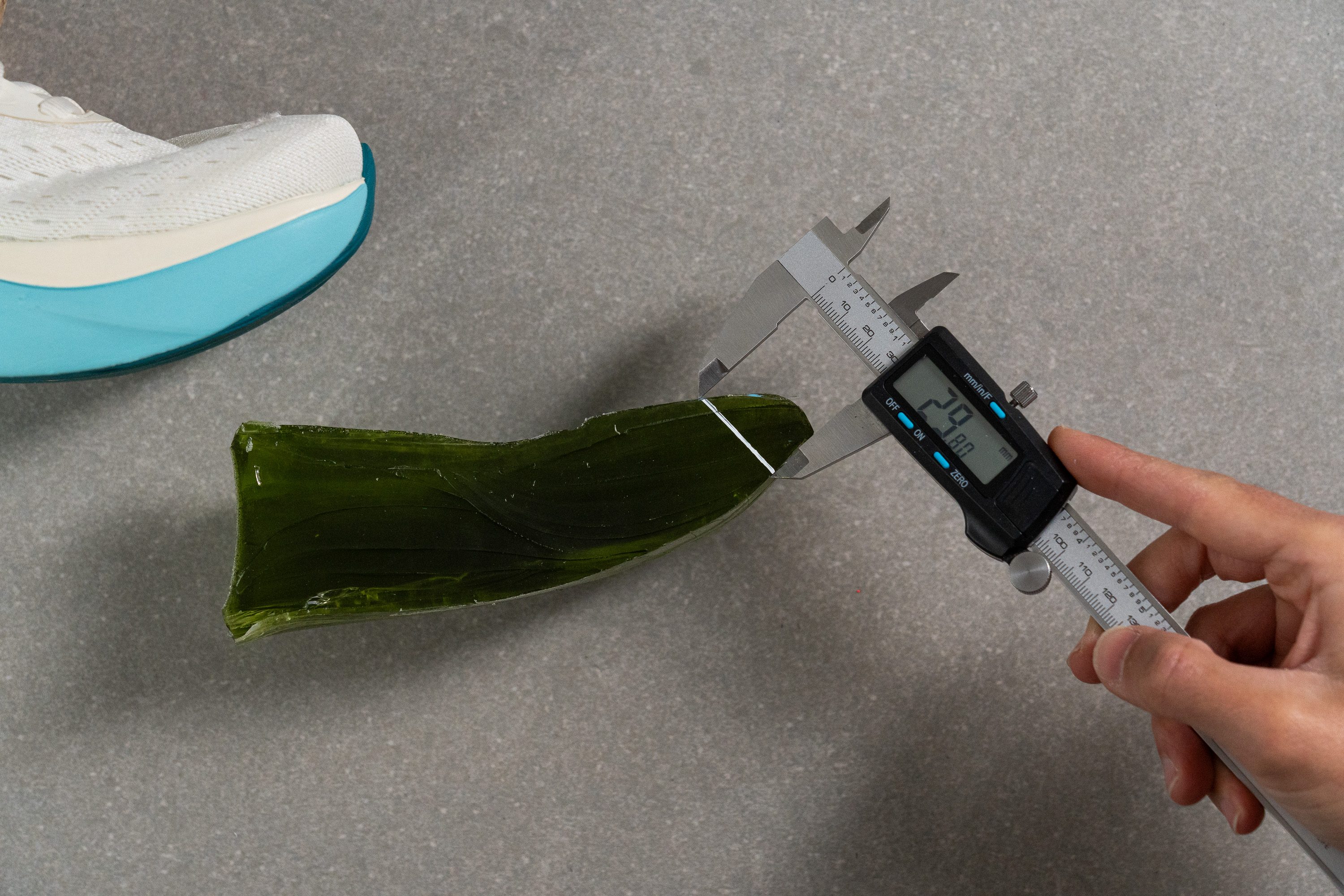
| Topo Atmos | 29.8 mm |
| Average | 27.0 mm |
Traction / Grip
Traction test
We found a 0.39 score during our lab test, which sits slightly below our current average, but that doesn't tell the whole story. This comfy daily trainer still delivers confident footing in rainy runs, making it a reliable all-weather pick.
| Topo Atmos | 0.39 |
| Average | 0.48 |
Outsole design
The Topo Atmos features a partially-covered outsole with big rubber segments over the heel and forefoot. These zones are embedded into a sculpted EVA base with oval cutouts that double as flex channels. A central oval groove runs lengthwise, further promoting midsole flexibility.
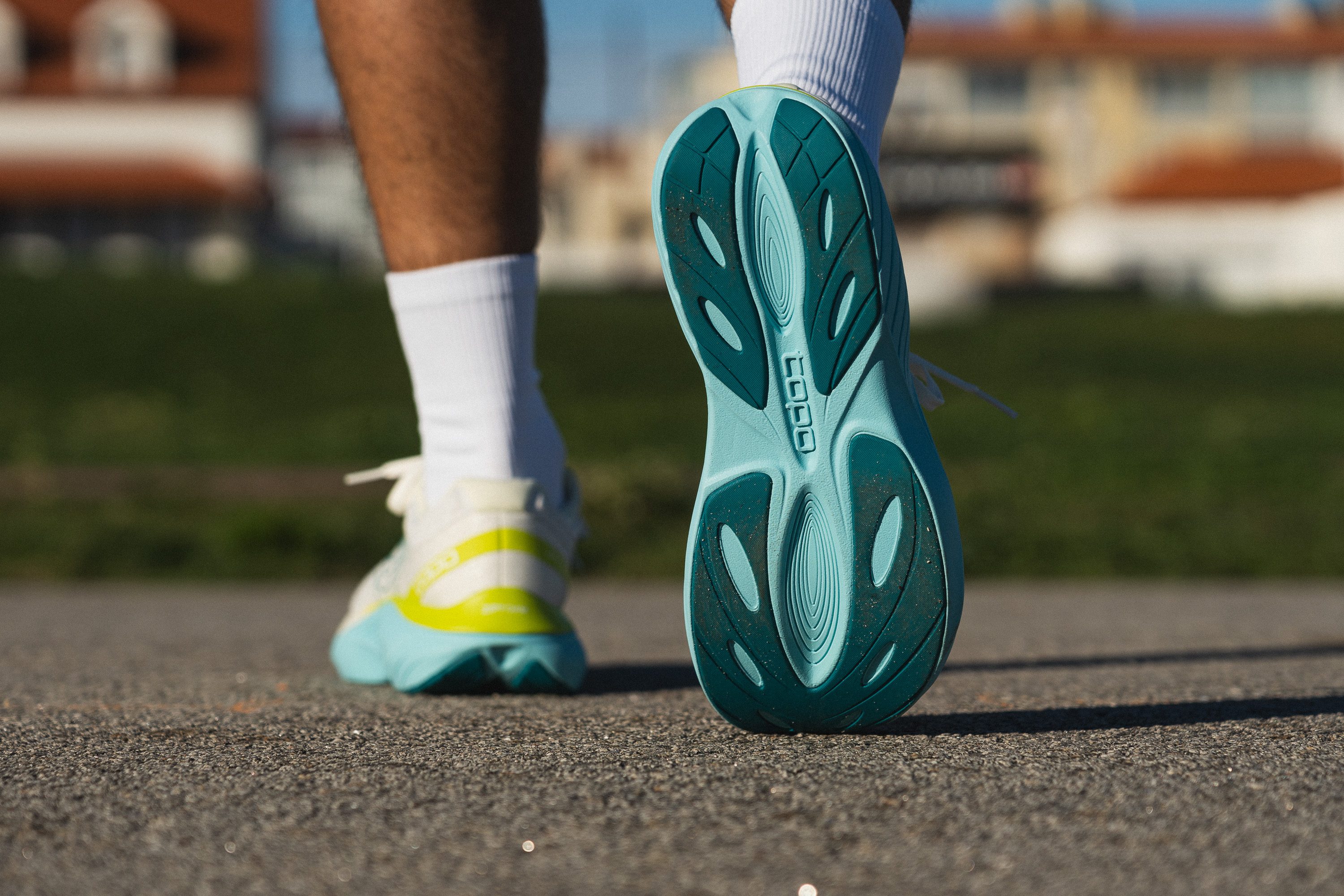
Flexibility / Stiffness
The Atmos surprised us with its rigid torsional rigidity, so we expected a high reading in our 30-degree bend test. Sure enough, we measured 15.1N, placing it at the firmer end for a daily trainer. In our experience, this limits flexibility, making it less ideal for super-easy runs.
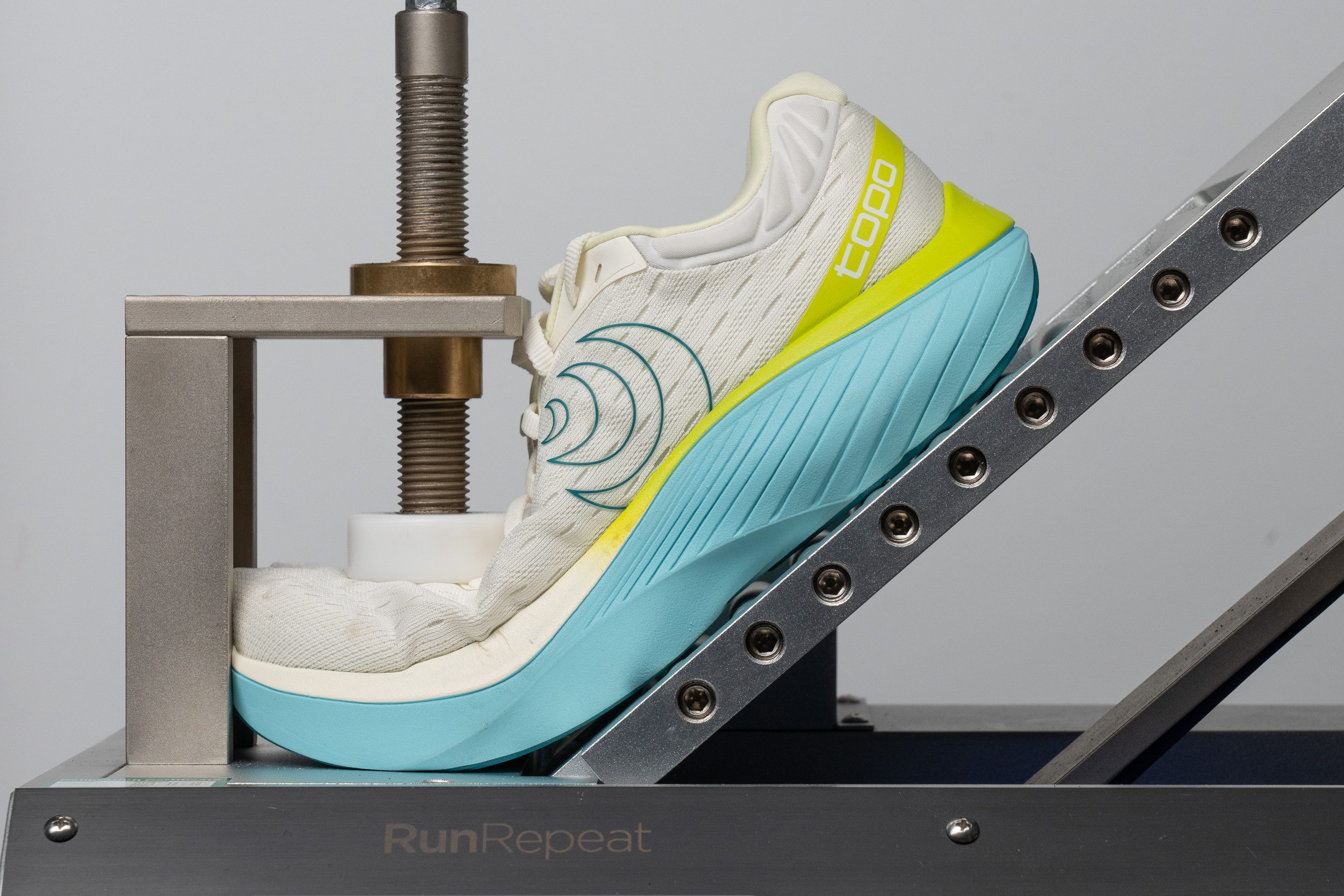
| Topo Atmos | 15.1N |
| Average | 15.3N |
Weight
Despite its bulky design and towering stack height, the Atmos defied expectations by weighing in at just 9.7 oz or 275g—surprisingly light for its dimensions. In our view, Topo did an impressive job here!
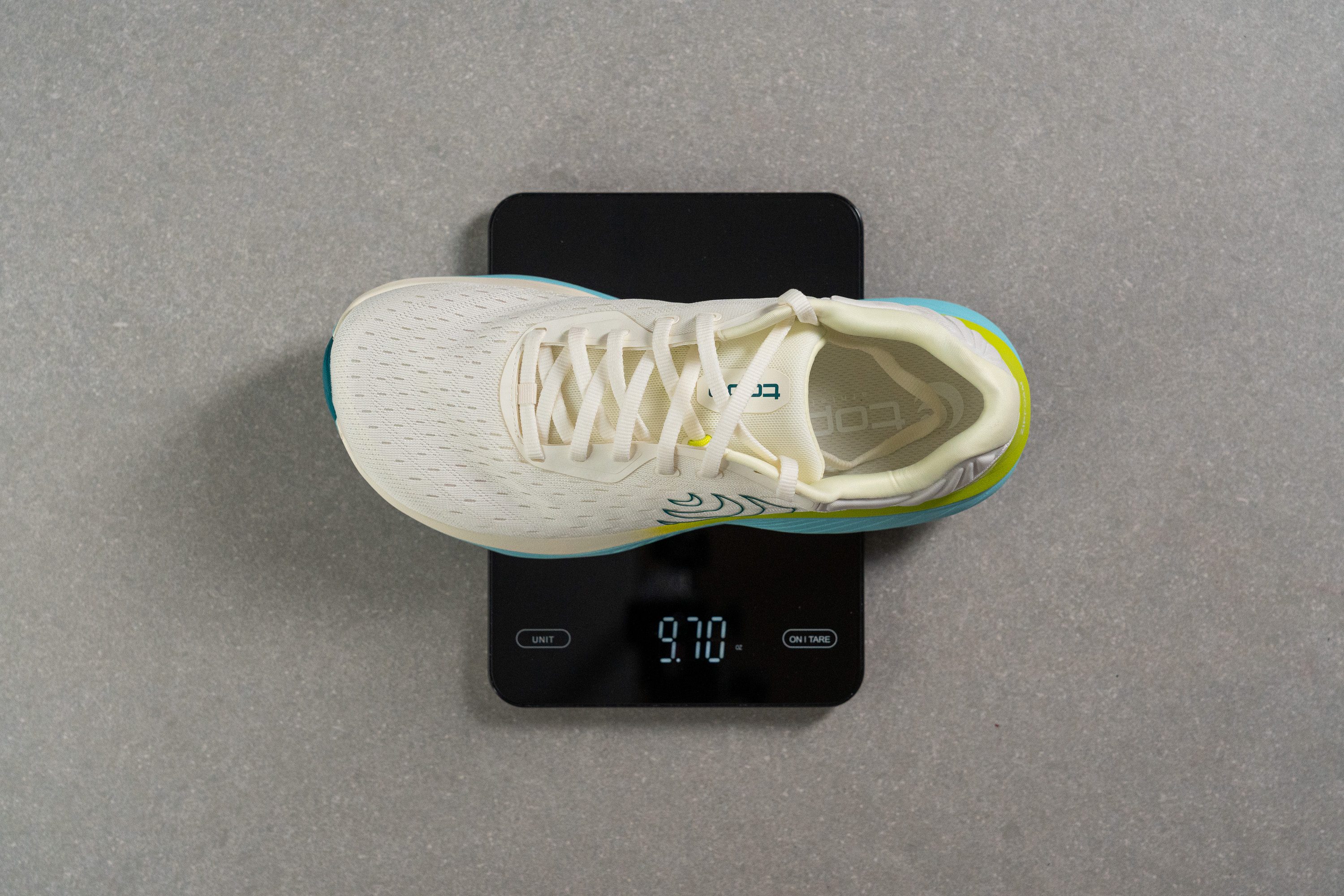
| Topo Atmos | 9.7 oz (275g) |
| Average | 9.3 oz (264g) |
Breathability
Right after unboxing the Atmos, we immediately noticed the abundance of ventilation holes across the upper. However, when we ran our hands over the engineered mesh, it felt noticeably thick—something that often limits airflow and reduces breathability.
Curious about its actual performance, we hooked it up to our smoke-pumping machine. The result? A decent 3/5 rating, ensuring solid ventilation for most seasons, though it might not be enough for super-hot summer days. On those occasions, we think pairing it with ultra-thin socks is the way to go.
We discovered that while the heel area is well-structured, the midfoot and toebox allow plenty of light to pass through. This suggests that Topo Athletic prioritised airflow in key areas while maintaining support for heel strikers—a balance we often see in daily trainers.
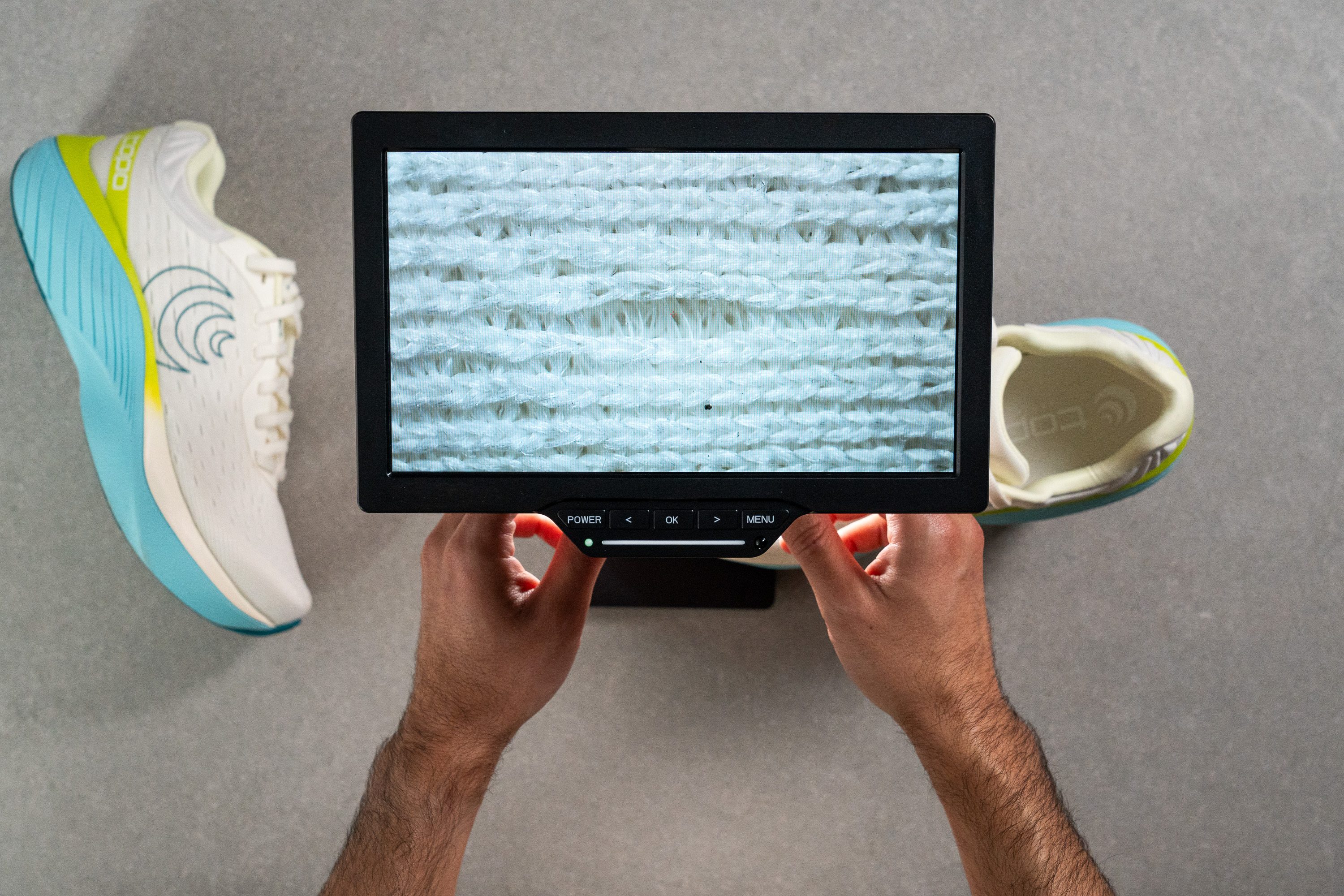
The engineered mesh itself isn’t particularly groundbreaking.
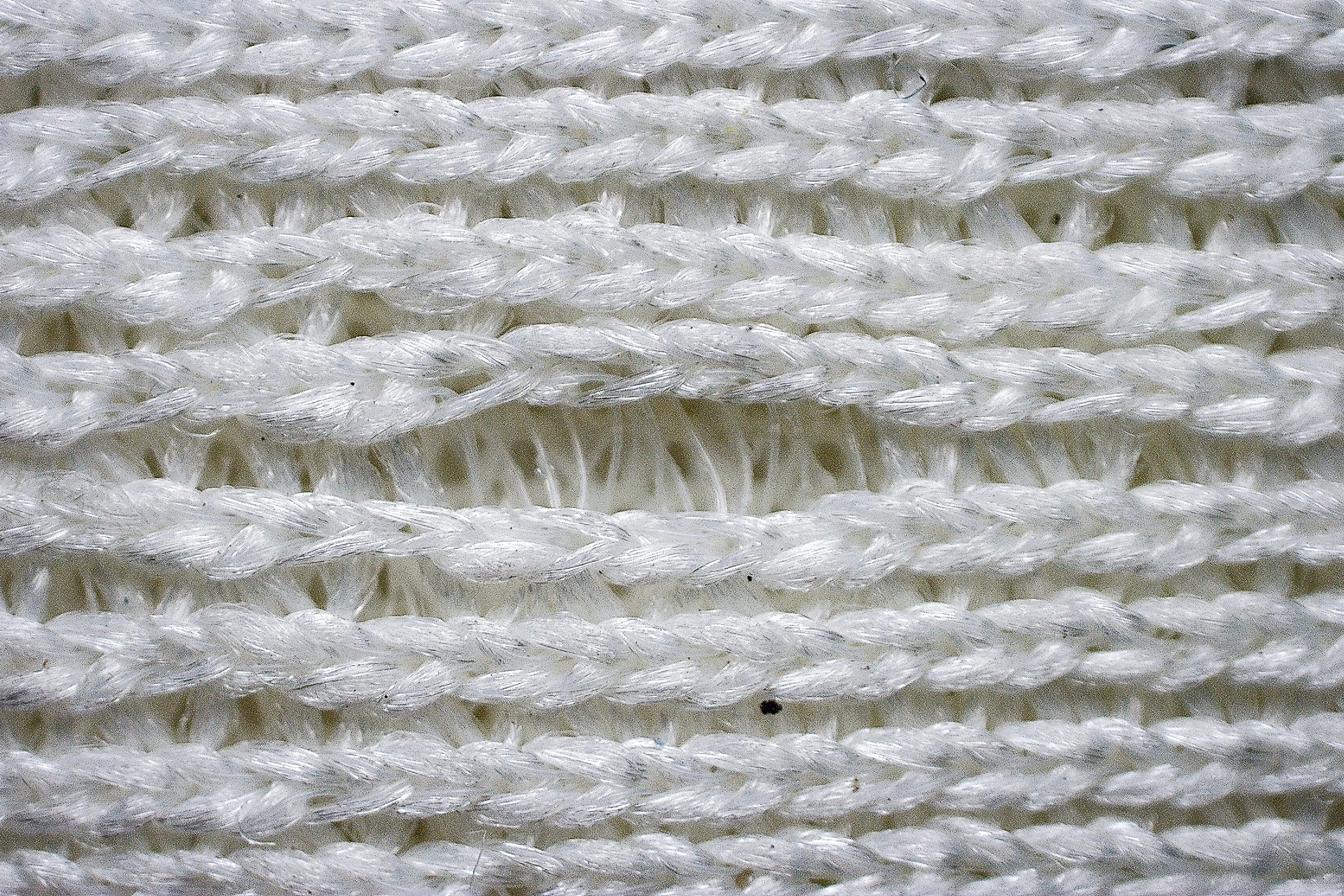
It follows the same dual-layer design found in most running shoes, aiming to enhance comfort and durability.
Overall, this upper plays it safe—Topo didn't push any boundaries here, instead opting for a reliable, no-frills approach in terms of design and materials. But if you ask us, we would have preferred just a bit more breathability.
| Topo Atmos | 3 |
| Average | 3.7 |
Stability
Lateral stability test
In our runs, we found the Atmos to deliver a decently stable ride, but we primarily recommend it for neutral runners or those with mild stability needs.
Its ultra-wide base, moderately supportive midsole sidewalls, and pronounced heel flare contribute to a solid platform, reinforced by a notably rigid build. However, despite these elements, runners who require a stability-focused design—like the Hoka Gaviota 5—should look elsewhere, as the Atmos doesn’t provide the structured support needed for severe overpronators.
Torsional rigidity
We were genuinely surprised by how rigid this shoe turned out to be. Despite having no plate or added stiffening elements in the midsole, it still maxed out our manual test with a 5 out of 5 score!
| Topo Atmos | 5 |
| Average | 3.5 |
Heel counter stiffness
The heel counter is also noticeably stiffer than what we typically find in a daily trainer, earning a solid 4 out of 5 rating. As we mentioned earlier, Topo clearly aimed to balance the shoe’s max stack with strategic design choices, and this is one of them. However, comfort remains intact thanks to the well-cushioned heel.
| Topo Atmos | 4 |
| Average | 2.9 |
Midsole width - forefoot
One of the most evident design choices in this shoe is its huge size, which, despite not being particularly heavy, gives it a somewhat bulky feel.
In our tests, we confirmed its oversized build in all directions—our digital callipers measured a substantial 119.1 mm in the first reading.
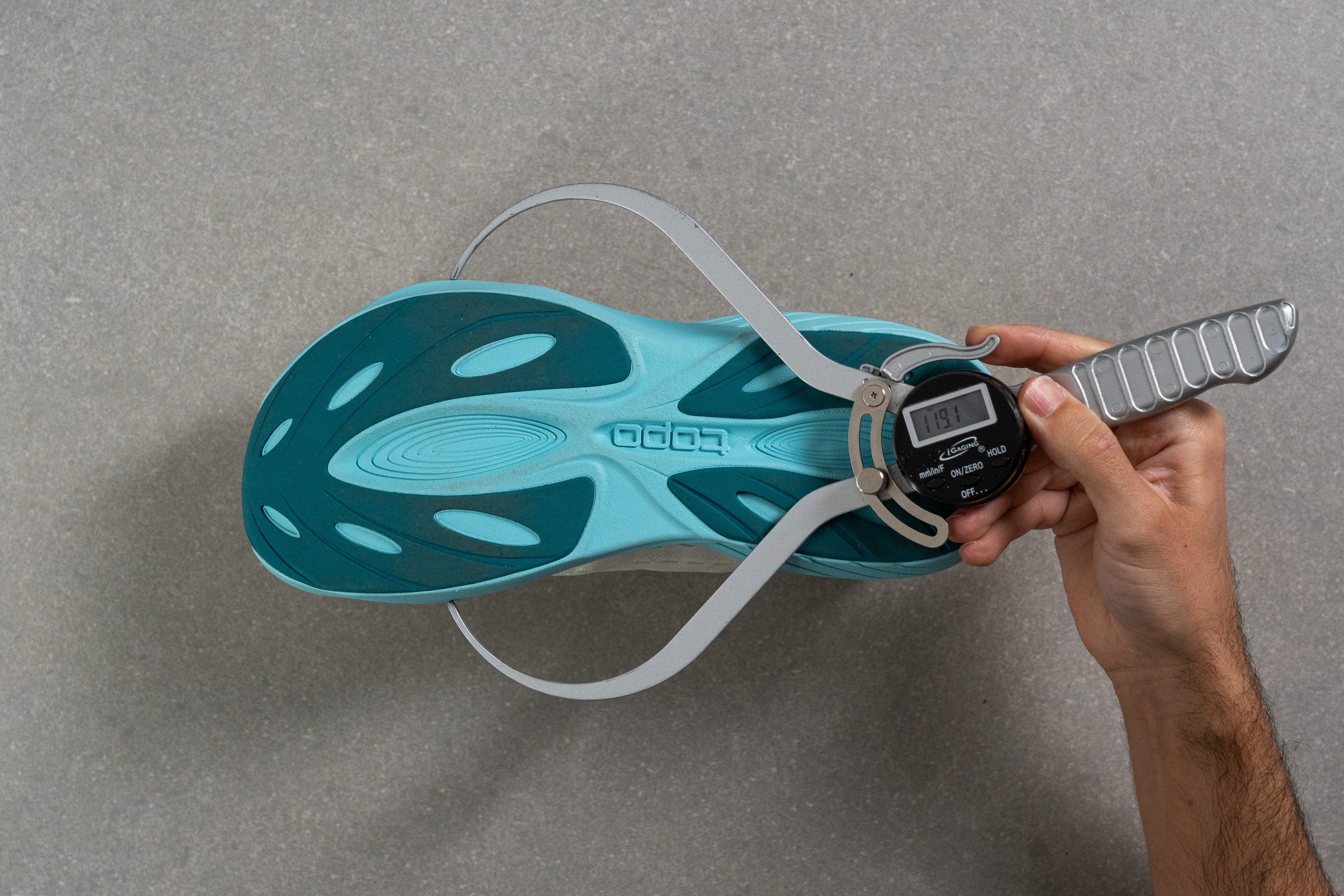
| Topo Atmos | 119.1 mm |
| Average | 114.3 mm |
Midsole width - heel
Our second measurement, this time at the heel, came in at an impressive 96.8 mm—wider than average relative to the forefoot. With its pronounced sole flare on the sides, this design suits heel strikers who prefer a low-drop setup.
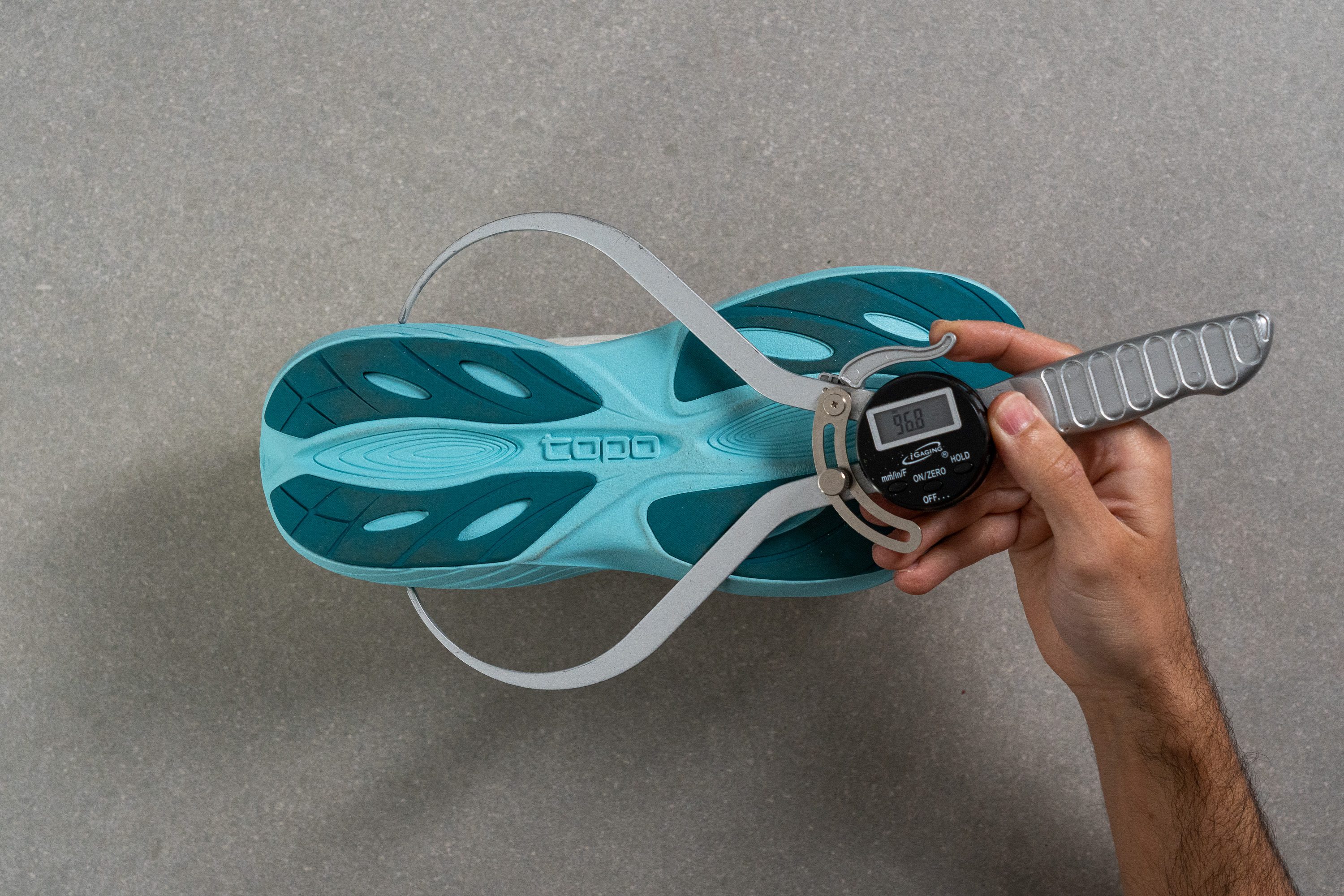
| Topo Atmos | 96.8 mm |
| Average | 90.7 mm |
Durability
Toebox durability
We fired up the Dremel for the first test of the day and found the upper to be less durable than expected, scoring a modest 2/5.
| Topo Atmos | 2 |
| Average | 2.6 |
Heel padding durability
However, it turned things around at the heel, where early wear is typically a bigger concern. Here, we were thrilled to give the Atmos a perfect 5/5 score.
| Topo Atmos | 5 |
| Average | 3.4 |
Outsole hardness
The Atmos outsole sticks to Topo’s usual design, featuring ample exposed foam to cut weight—though this could compromise durability.

Even with less-than-usual rubber coverage, the 76.5-HC compound provided reliable traction on roads. However, we wouldn’t recommend it for dirt roads or gravel paths.
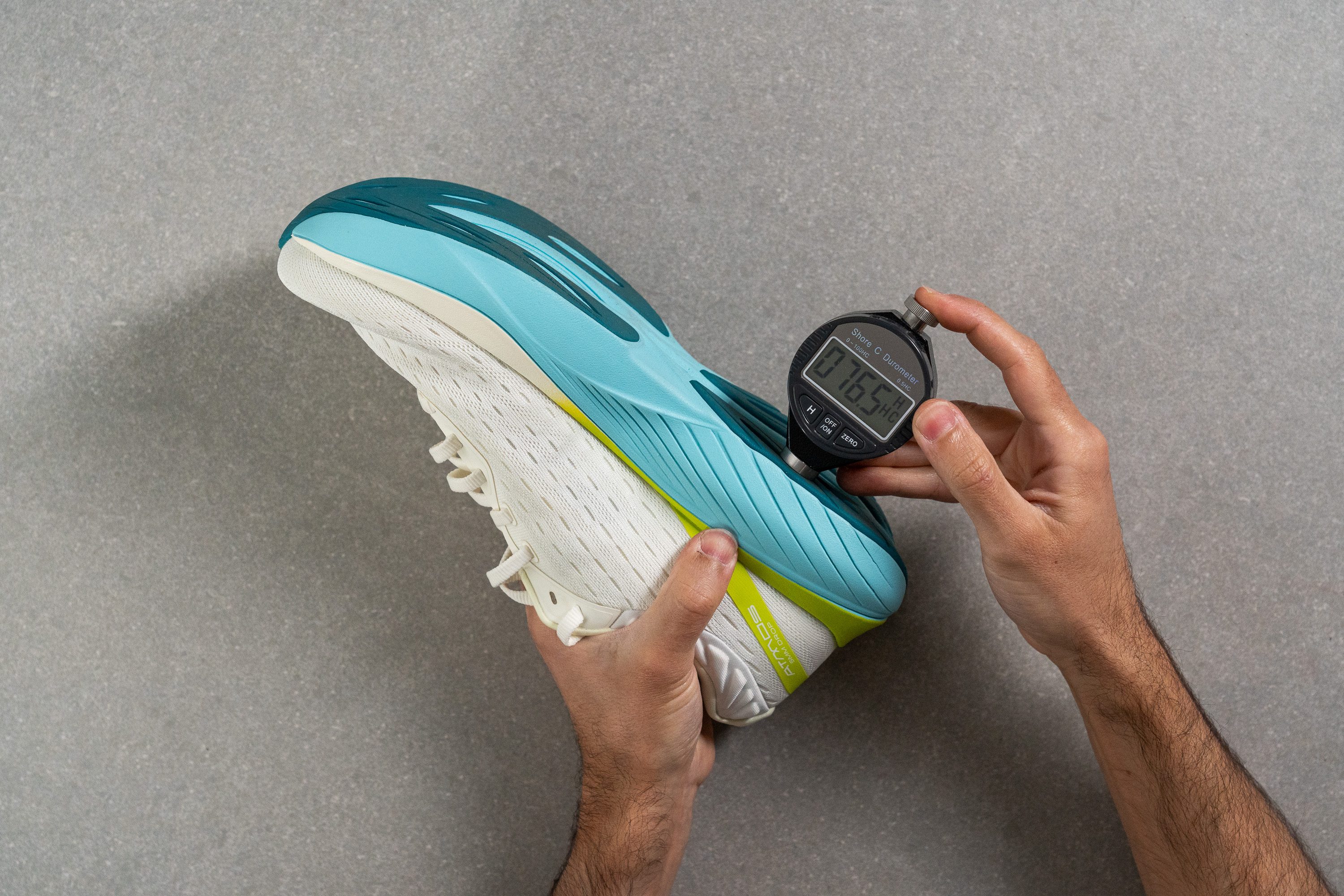
| Topo Atmos | 76.5 HC |
| Average | 79.2 HC |
Outsole durability
This test was crucial for the Atmos, as poor performance would have been a major concern given the minimal rubber on the outsole.
Fortunately, we discovered solid results with just 0.8 mm of wear, indicating that despite its foam-exposed build, durability should be around average like in most daily trainers.
| Topo Atmos | 0.8 mm |
| Average | 1.1 mm |
Outsole thickness
We were relieved to find a generous 3.4 mm of outsole thickness, which is quite substantial—especially for a Topo Athletic shoe.
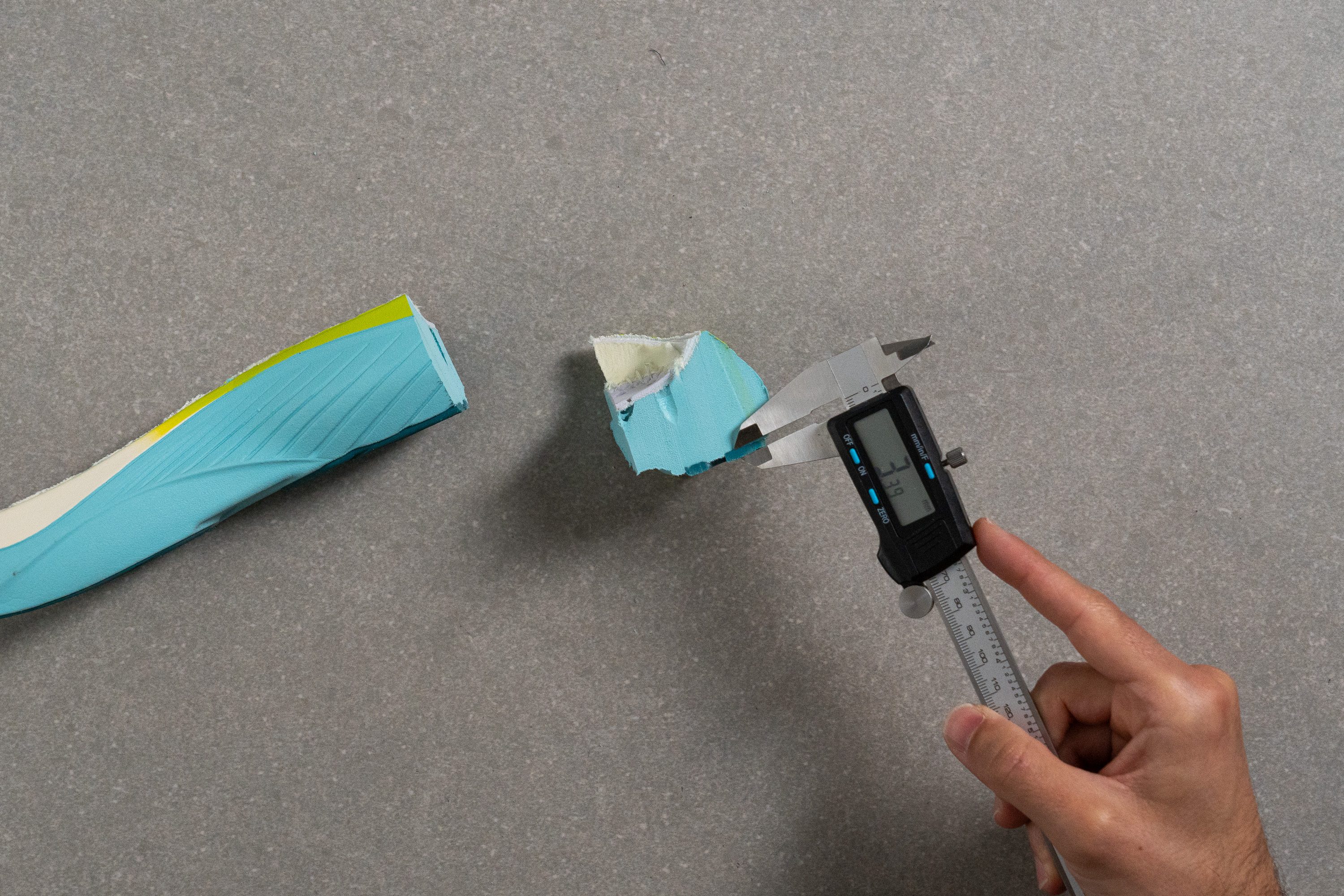
| Topo Atmos | 3.4 mm |
| Average | 3.2 mm |
Misc
Insole thickness
The insole contributes extra cushioning with its 4.1 mm thickness, enhancing overall comfort.
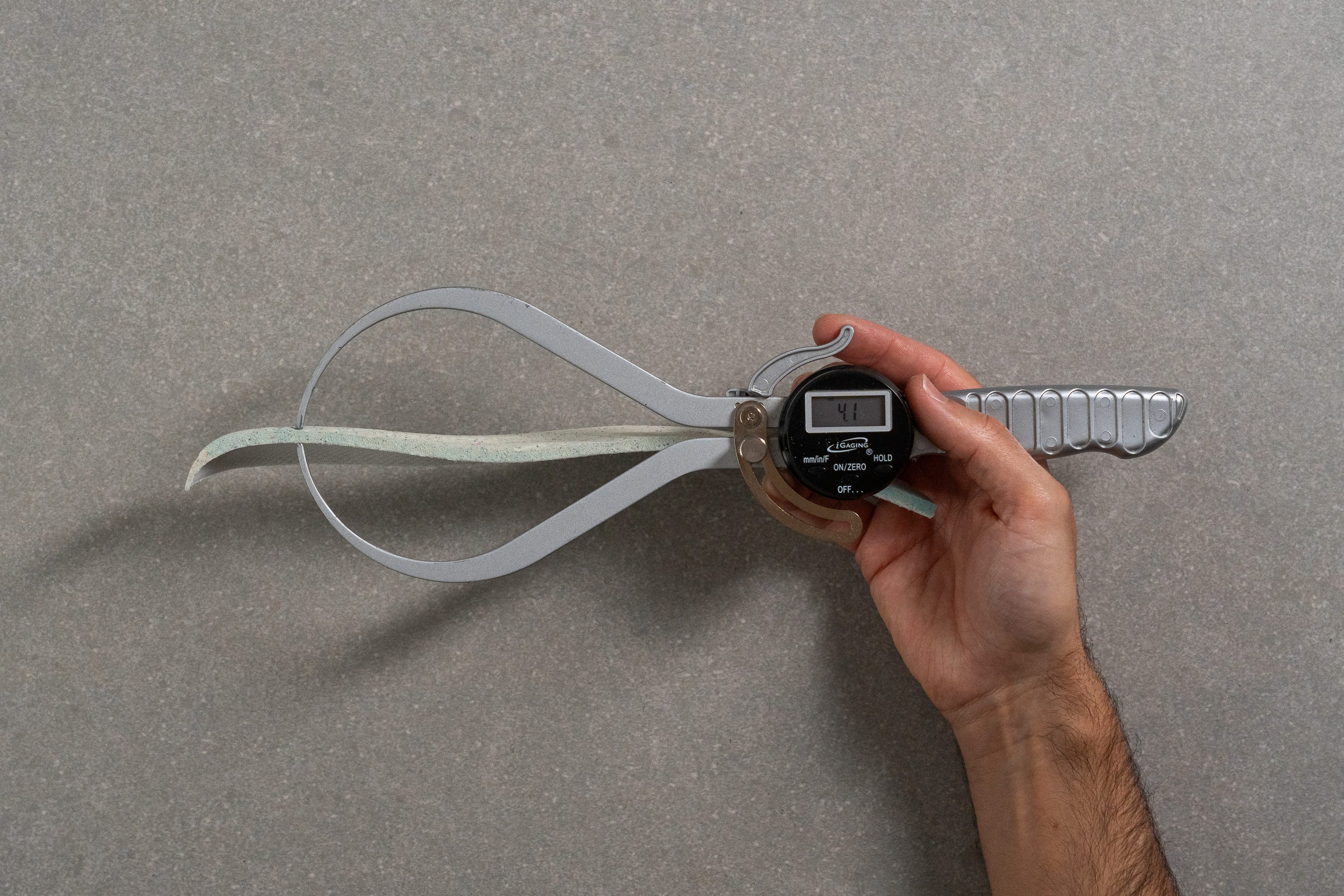
| Topo Atmos | 4.1 mm |
| Average | 4.5 mm |
Removable insole
The Atmos comes with a replaceable Ortholite insole, but we found it to be a key component of the shoe’s comfort. Swapping it out means losing the plush feel and responsive cushioning that enhance the ride.
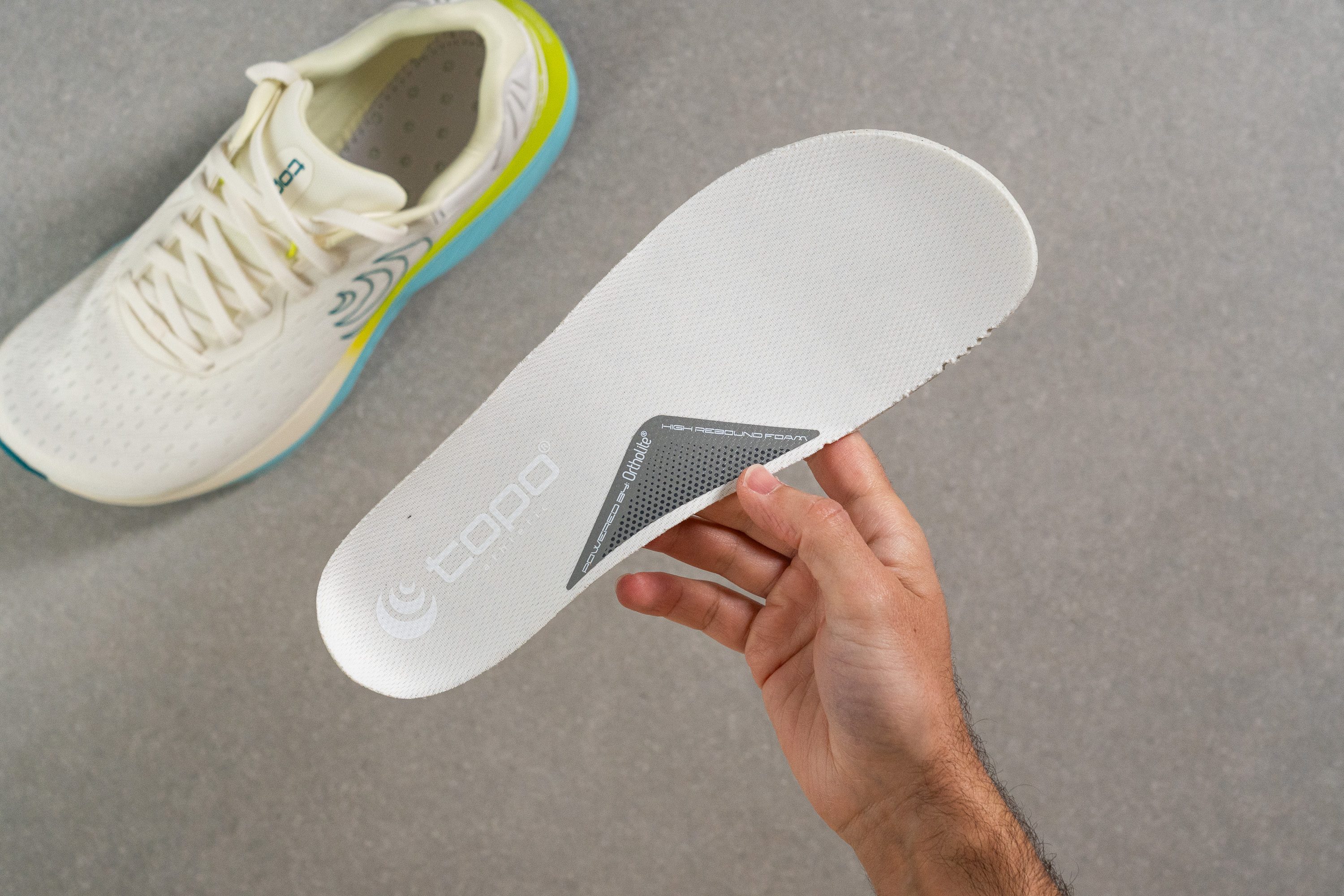
| Topo Atmos | Yes |
Midsole softness in cold (%)
A 28% change in softness after 20 minutes in the freezer is a solid result for an EVA-based foam, so we were pleased with its cold-weather resilience.
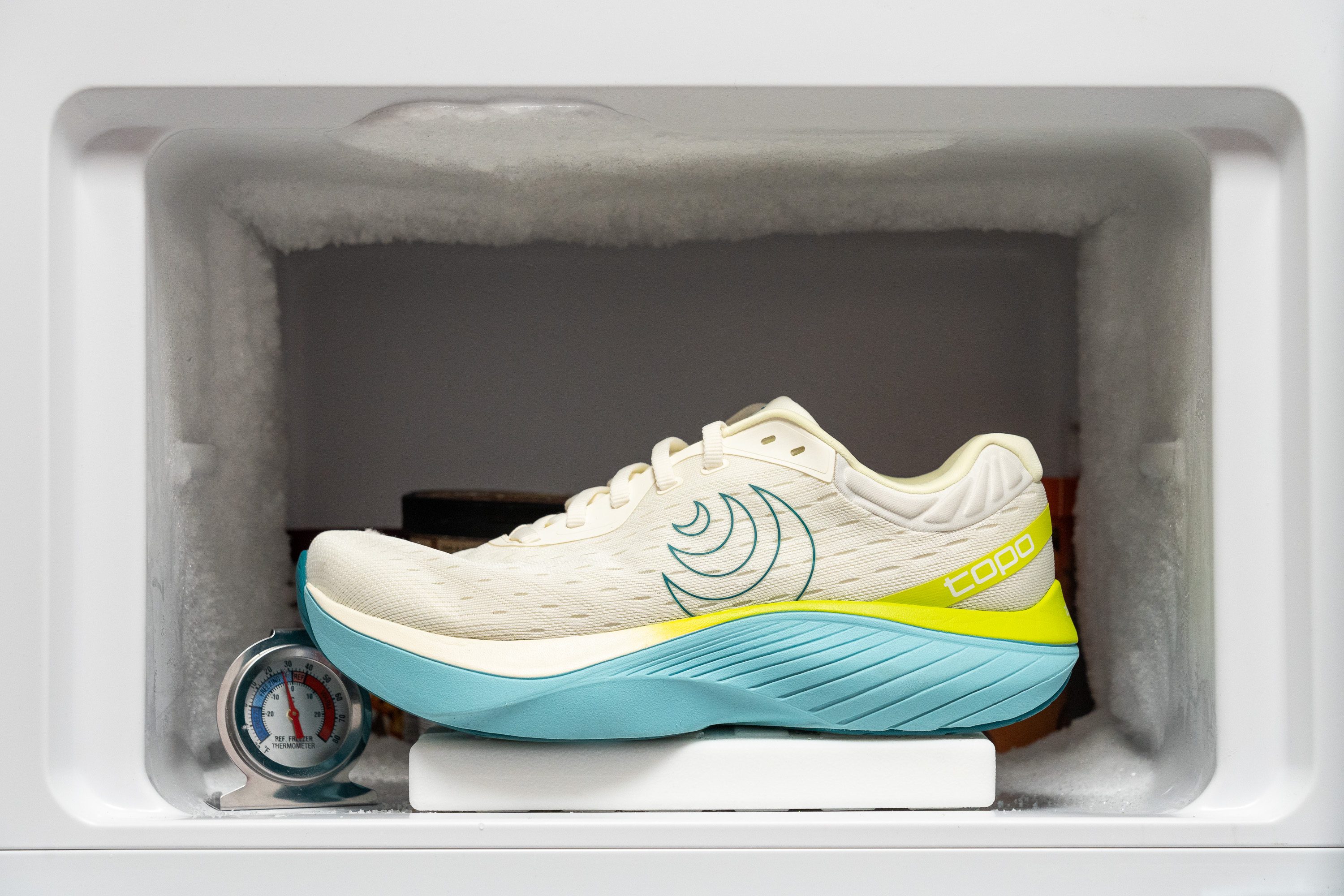
| Topo Atmos | 28% |
| Average | 24% |
Reflective elements
Topo left out reflective elements on the Atmos—a missed opportunity to enhance visibility and safety for night runs.
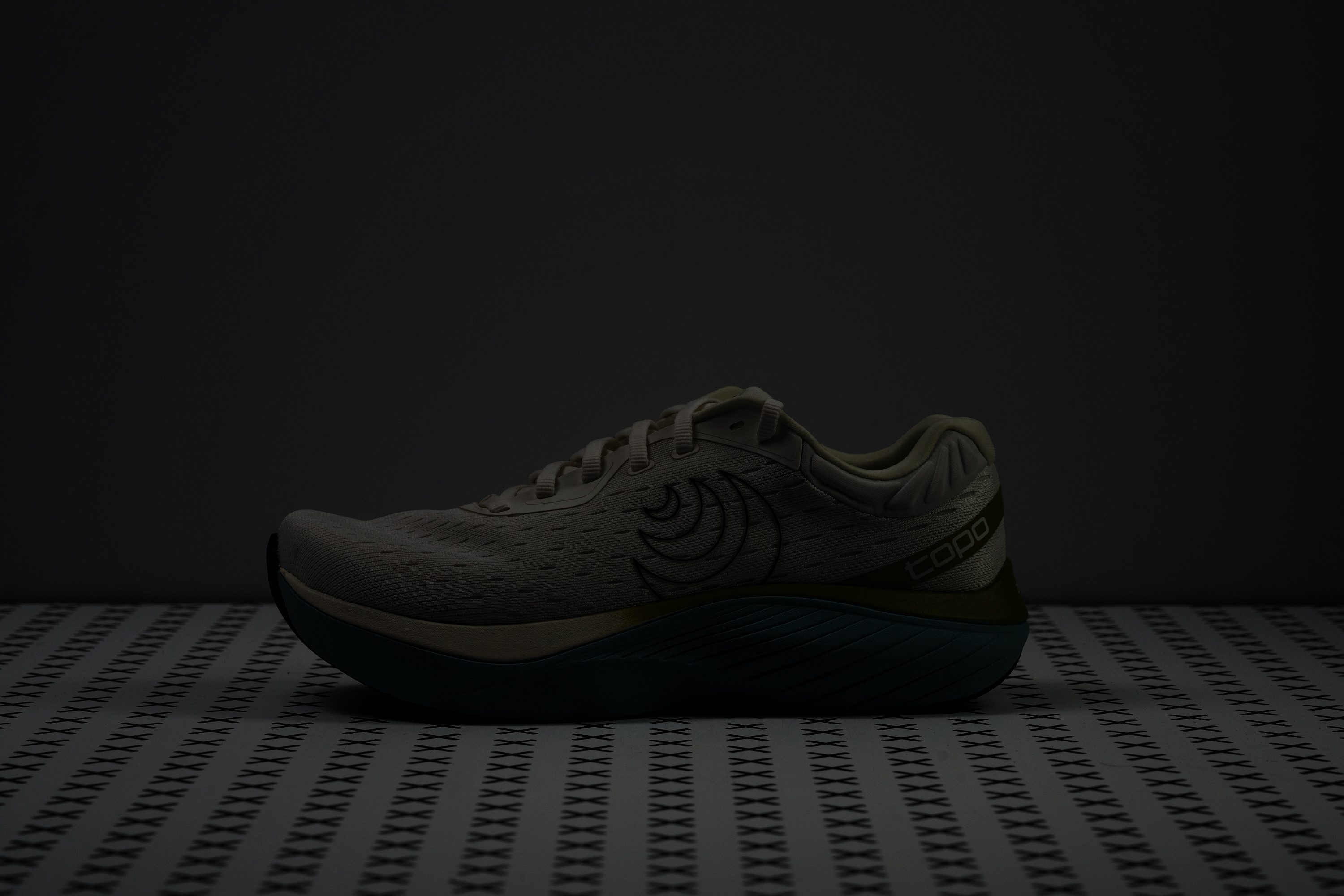
| Topo Atmos | No |
Tongue padding
One of the cool features in the Atmos is its uniquely designed tongue. Topo uses two small loops—one on each side—near the last eyelet, instead of the single loop of most running shoes. We found that this unique design significantly improves lockdown for this shoe because it keeps the tongue centred at any pace.
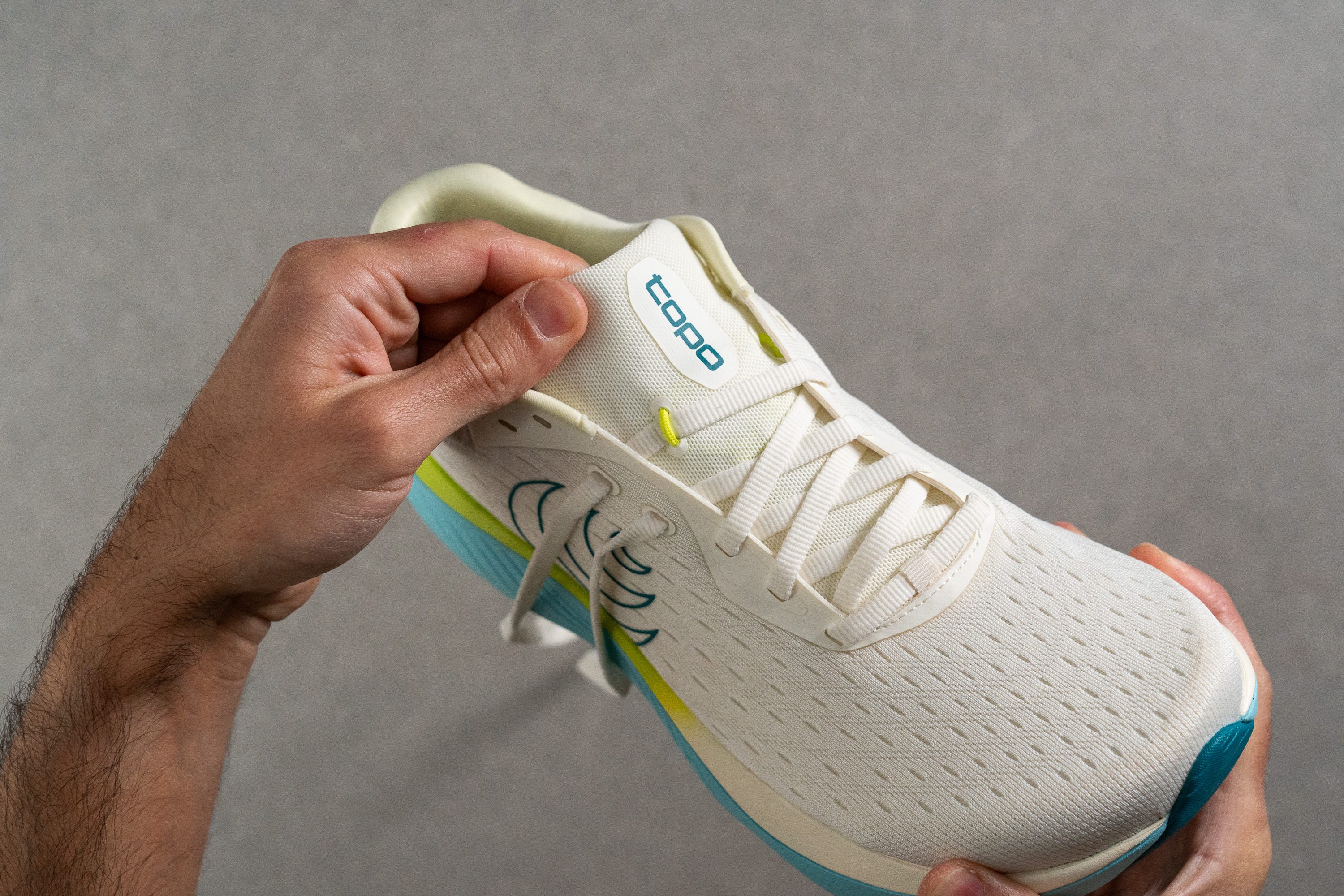
We measured the tongue at a well-balanced 6.5 mm, providing the right mix of comfort and weight savings. In our experience, it offered just the right amount of padding and we never felt any pressure or pain.
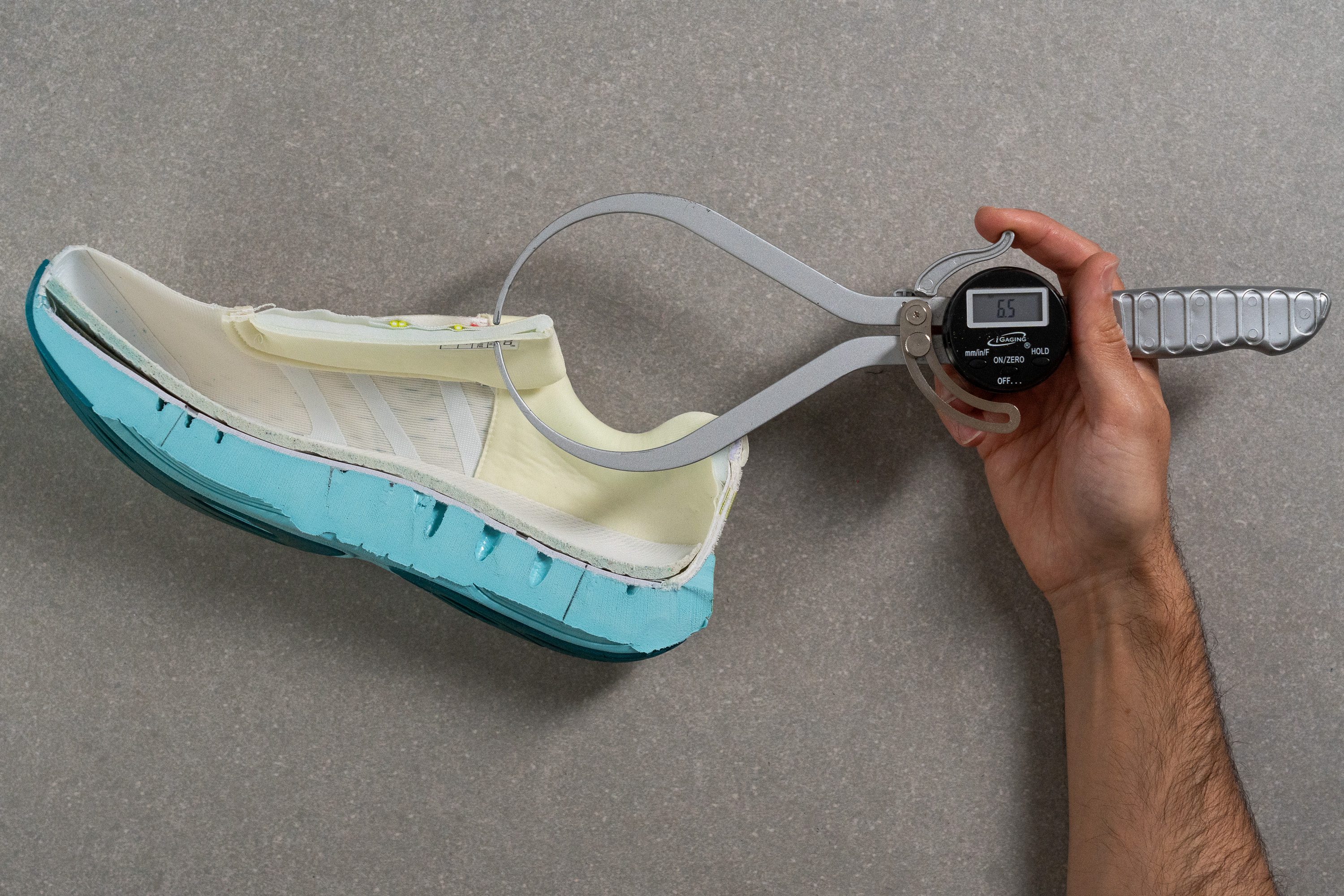
| Topo Atmos | 6.5 mm |
| Average | 5.8 mm |
Tongue: gusset type
Those two loops play a crucial role since the Atmos features a tongue that isn’t gusseted. In most running shoes, we’re not fans of this design, but we believe Topo pulls it off with this innovative approach, keeping the tongue secure without fixing it to the sides.

| Topo Atmos | None |
Price
If performance is your priority, the Topo Atmos may feel pricey since that's not its main strength. However, for runners with high-volume feet seeking comfort and reliability for daily miles, it's a strong contender for its price tag. Plus, its niche status offers a unique alternative to mainstream options.
| Topo Atmos | $160 |
Heel tab
As with all Topo road running shoes, the Atmos skips a heel tab, opting for a clean, minimalist design in this area.
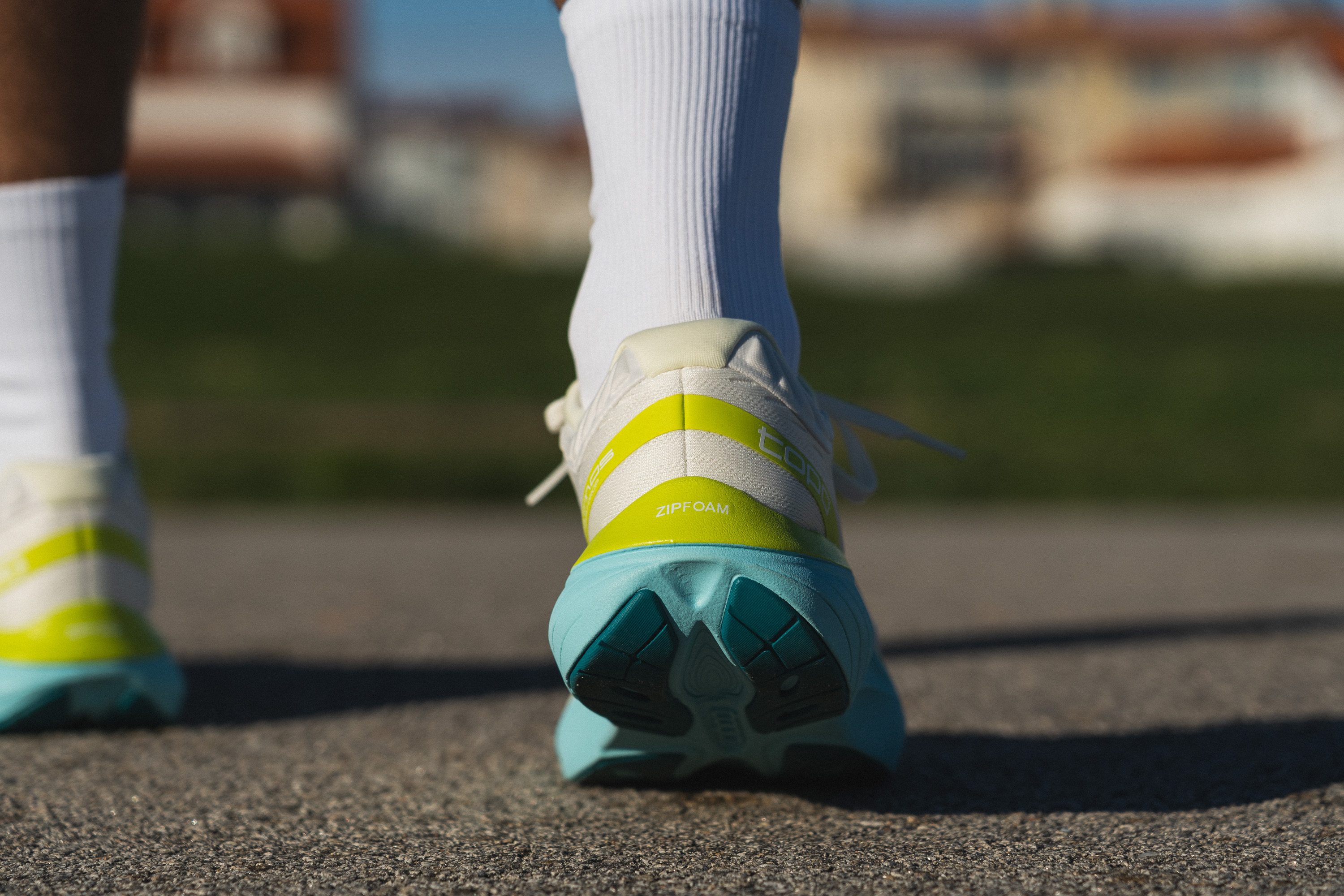
| Topo Atmos | None |

